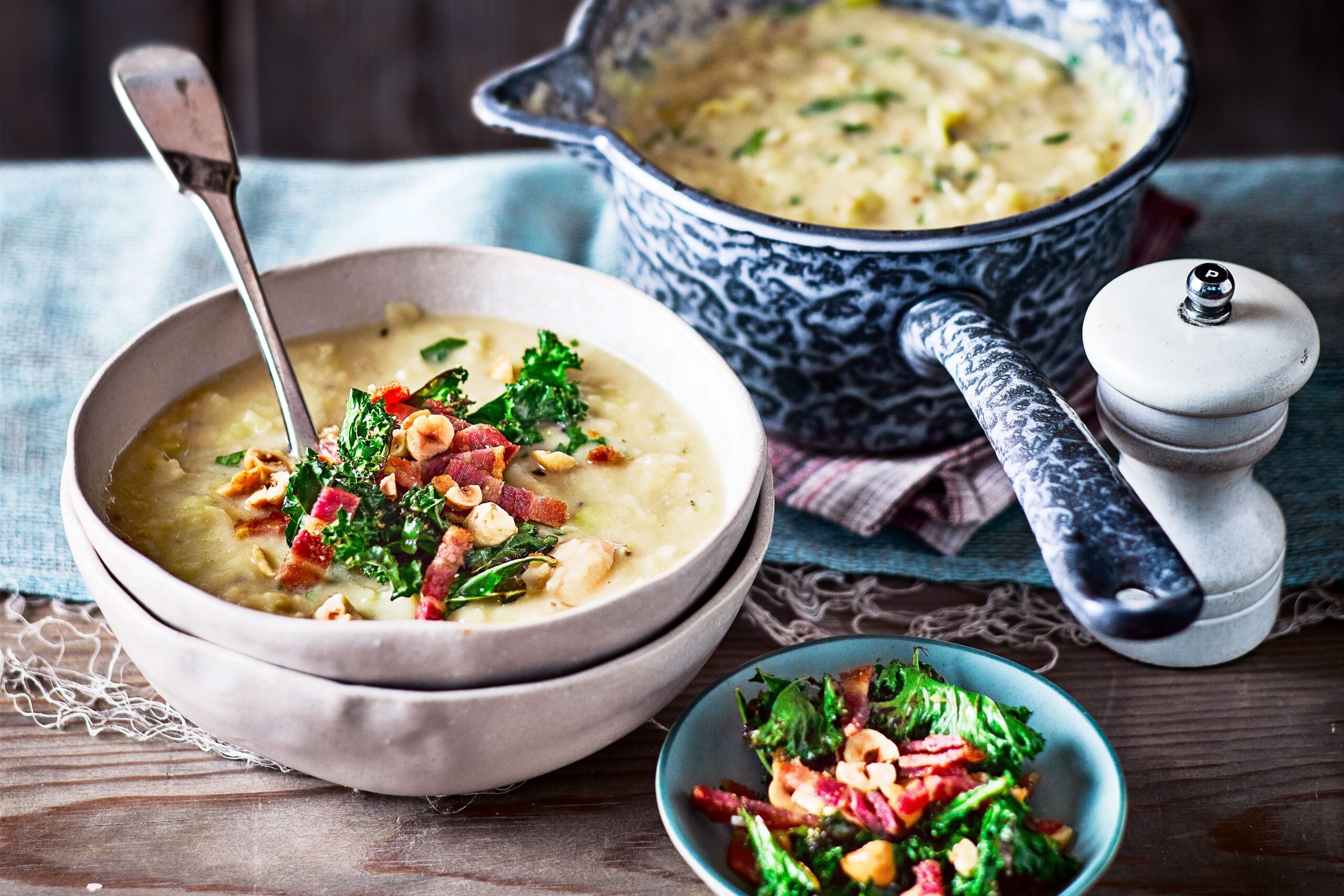The blender debate rages on: convenience enthusiasts clash with traditionalists, igniting a kitchen war reminiscent of the battle over culinary technology in the age of food processors vs. hand methods, as households grapple with the clash between high-tech gadgets and simple, time-honored tools.
From smoothies to soups, blenders serve as the workhorses of contemporary kitchens, embodying the duality of convenience and culinary tradition. The rise of blending technology has transformed not just the way we prepare food but also how we think about nutrition, accessibility, and lifestyle. However, this convenience and modernity come at a time when culinary arts are often characterized by an ongoing debate over authenticity versus innovation.
Blenders vary dramatically in design, function, and price, ranging from premium models boasting cutting-edge features to more basic, budget-friendly options. The influx of high-tech offerings, such as the Ninja Detect 3-in-1 Power Blender and Food Processor, raises questions about what it means to be a cook today. At a price point of approximately £229.99, this model showcases innovative features such as a BlendSense function, which adjusts blending speed based on the ingredients’ consistency. This development may indicate a shift in the culinary landscape as home cooks seek to leverage technology to achieve professional results. With blenders like these, once-intimidating tasks such as puréeing hot soups or blending frozen fruits become manageable, thereby appealing to a demographic that values convenience and efficiency.
Yet, amidst these innovations, traditionalists may lament the loss of raw, tactile cooking skills that embody an intimate connection to food. Many enthusiasts value the cultural significance of preparing meals by hand. Crafts like chopping vegetables, stirring pots, and using mortar and pestle evoke a sensibility that modern gadgets cannot replicate. Kitchen appliances serve to simplify tasks, yes, but at what cost to the culinary experience? The tactile joy of cooking—interacting with ingredients, feeling textures, and honing cooking skills—seems to diminish as reliance on technology increases.
Moreover, blenders like the Cuisinart Blast & Go Portable Blender, priced at £69.99, illustrate the growing trend of convenience-focused appliances that are compact and easy to use. The trend towards portability has coincided with a rise in health consciousness, as many consumers now prioritize smoothies and health drinks packed with nutrients on-the-go. The emphasis on personal wellness from quick and accessible options reflects societal shifts towards prioritizing health in daily life. However, it also raises questions about the ramifications of this shift. Are we, as consumers, conceding to a lifestyle that sacrifices quality and flavor for convenience? This tension plays out across kitchen counters worldwide as families grapple with the limitations of modern devices.
The practicalities of cleaning and maintenance further complicate this conversation. Devices like the Haier I-Master Series 5 Glass Jug Blender, while acclaimed for their ease of clean-up, still require equal evaluation against traditional methods that emphasize longevity and craftsmanship. Would a hand-cranked model or classic food processor offer a more meaningful experience and lower maintenance over time? For many, the durability and simplicity of non-electronic tools could prove to be more rewarding than the conveniences offered by advanced technology.
The rise of trends favoring eco-friendliness also intersects with modern blending technology. Brands, many of which emphasize sustainability in their design and materials, are increasingly focusing on minimizing their environmental footprint. The packaging of these products is equally scrutinized; consumer preference leans towards blenders with low-impact materials or recyclable packaging. For instance, the Russell Hobbs Desire Jug Blender stands out as a budget option priced around £58.99, yet it successfully demonstrates that affordability does not have to come at the price of sustainability.
There is also a growing segment of the market targeting consumers who prioritize aesthetics along with functionality. Blender manufacturers like Smeg leverage retro designs and vibrant colors to appeal to those who see kitchen appliances as an expression of personal style. The Smeg BLC02WHMUK, priced at £499.95, highlights this trend. Its striking design may command a higher price, but consumers are often willing to pay, believing such styles blend seamlessly into their kitchen’s decor. However, one must question whether this is simply the expression of consumerism dressed in designer labels or a meaningful investment in a quality product that will enhance culinary experiences.
To further dissect consumer behavior, the argument presents itself that modern blending technology bifurcates culinary practices, fostering a reliance on speed and efficiency while compromising sensory engagement in cooking. As lifestyle choices promote faster meals with fewer ingredients, the art of cooking can quickly devolve into an impersonal process. This detachment fosters a reliance on store-bought packaged goods, making it difficult to appreciate the flavors and freshness of whole ingredients.
In contrast, one must consider the impact of a high-powered blender in accomplishing complex tasks that may have previously required manual effort and time—baking, sauces, nut butters, and beyond. A multi-functional device such as the Nutribullet Ultra encourages families to revisit the creativity in the kitchen by allowing home chefs to expand their culinary repertoire. Its innovative blend design makes it suitable for preparing everything from smoothies to different sauces, thus nurturing an interactive cooking experience tailored to modern tastes.
As more households embrace these powerful kitchen tools, the question shifts from merely whether one should use a blender to when and how they can maximize its potential. As culinary norms evolve, the onus shifts to consumers to create a balance that embodies tradition and innovation, practicality and aesthetics.
Ultimately, blenders underscore a complex societal relationship with cooking and food in a modern context, raising the question of what preferences reveal about our collective identity as cooks and consumers. The rise of powerful, multifunctional devices heralds a new era, but the fundamental appreciation for food, human connection, and culinary art remains pivotal—not merely as a debate in the kitchen but as a reflection of our broader lifestyle choices and values.
From whizzing up smoothies and cocktails to blitzing sauces and soups, blenders are one of the most indispensable kitchen appliances when it comes to making popular everyday recipes.
Whether you’re looking for a timesaving gadget to make breakfast smoothies for all the family, or a nifty portable blender for whizzing up slushies on a summer holiday or picnic, blenders come in all manner of shapes, sizes and budgets.
To save you time and to help you find the best model for your needs, we’ve put more than 40 blenders to the test in recent years, from premium models from the likes of Sage and KitchenAid to portable intuitive pieces of kit from Ninja and Nutribullet. Read on to find our pick of the best.
View Affiliate Playlist on the source website
Best blenders at a glance
5/5 stars
- Best compact and portable blender: Cuisinart Blast & Go Portable Blender, £69.99
- Best high-tech blender: Ninja Detect 3-in-1 Power Blender and Food Processor, £229.99
- Best blender for easy clean-up: Haier I-Master Series 5 Glass Jug Blender, £89
- Best portable blender: Ninja Blast cordless blender, £49.99
- Best blender for keeping on the countertop: KitchenAid K400 blender, £329
- Best blowout blender: Sage the Super Q blender, £599.95
Best of the rest
- Best blender for doing it all: Nutribullet Triple Prep System, £229.99
- Best all-round blender: Nutribullet Ultra, £149.99
- Best blender for batch cooking: ProCook food blender and smoothie maker, £149
- Best smoothie blender: Smeg BLC02WHMUK, £499.95
- Best budget blender: Russell Hobbs Desire jug blender, £58.99
- Best blender for travel: Nutribullet Flip, £99.99
- Best blender with built-in scales: Kenwood MultiPro OneTouch food processor and blender, £199.99
- Best blender for small spaces: Nutribullet Magic Bullet Blender, £49
- Best jug blender: Zwilling Enfinigy table blender, £199
- Best family-sized blender for soups and smoothies: Nutribullet SmartSense Blender Combo, £149.99
Jump to:
How we tested blenders
We tested nearly 30 blenders overall, from the basic and budget to the high-tech, using the same smoothie concoction (1 beetroot, ⅓ carrot, handful kale and 500ml water) to test the blenders’ ability to handle tough and fibrous ingredients.
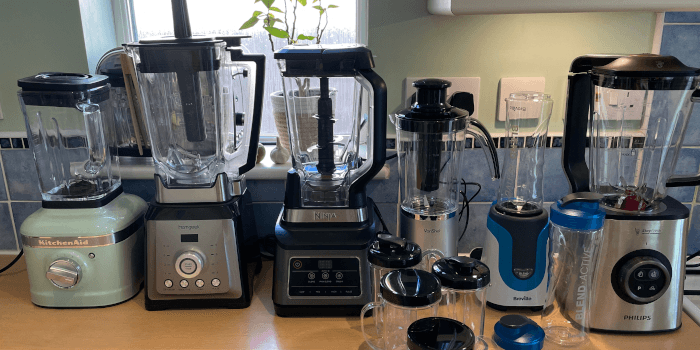
We also tested them by making a super berry smoothie with frozen fruits to determine the overall quality and effectiveness of the blender with icy lumps and its all-important blade. Tomato sauce has the ability to stain containers, so we also assessed each blender on how easily we could clean away those red stains and lingering smells.
- Blade strength: Could the blade easily blend our smoothie mix without struggling?
- Speed of blitzing: How quickly and efficiently did the smoothie blend?
- Ease of use: Was the blender easy to set up, put together, take apart and clean? Was it straightforward?
- The jug: How heavy and durable was the jug? Was it shatter-resistant? Plastic or glass? If plastic, was it BPA-free?
- Safety: Does it come with a safety lock? How tightly does the lid fit?
- Loudness: All blenders generate noise, but were there any that were quieter or louder than others?
- Functions: How many speed settings? On top of blending, are there any other functions, such as pulse, crushing ice etc? Any pre-set functions to make things such as soups and smoothies? Auto-clean?
- Results: How well blended was the smoothie? Any lumpy bits leftover, or was it completely smooth?
- Design and aesthetic: Is it well designed or bulky? How much space does it take up on the counter? Does it justify its size? Does it pack away easily in a cupboard?
- Packaging: Is it well-packed, or does it come with excess packaging etc?
Find out more about how testing works at Good Food by heading over to our how we test page.
Best blenders to buy in 2025
Good Food in partnership with Tower jug blender
Available from Amazon (£79.99), Tower (£79.99 – save 10% with code GOODFOODNEW)
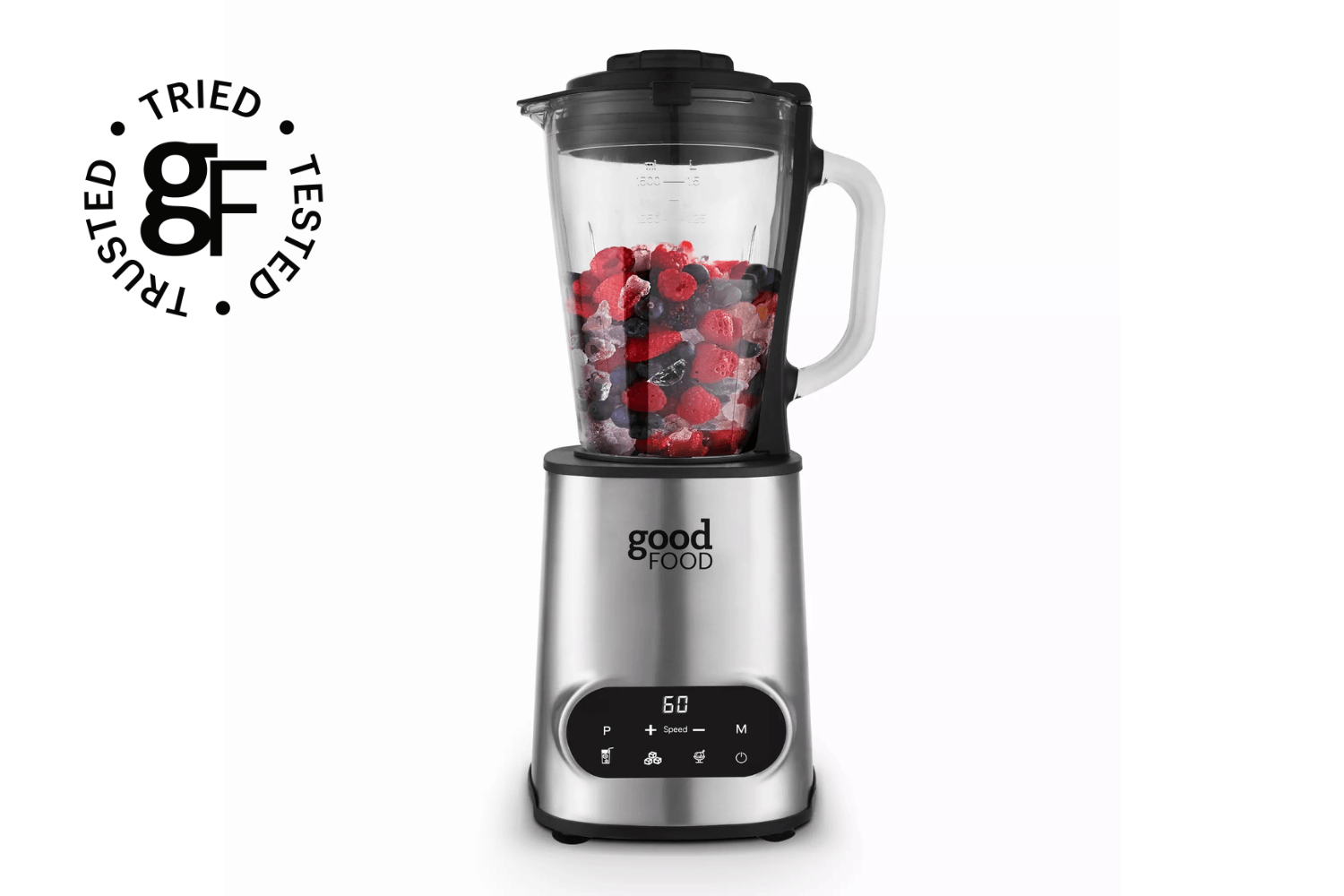
This sleek jug blender combines power, precision and ease of use. With a 1200W motor, 10 speed settings and three pre-set functions, it tackles everything from crushed ice to fruity smoothies. The 1.5L glass jug is ideal for sharing, while the digital control panel and ergonomic handle make blending and pouring effortless.
Available from:
Cuisinart Blast & Go Portable Blender
Available from Cuisinart (£69.99), Amazon (£69.99), Lakeland (£69.99)
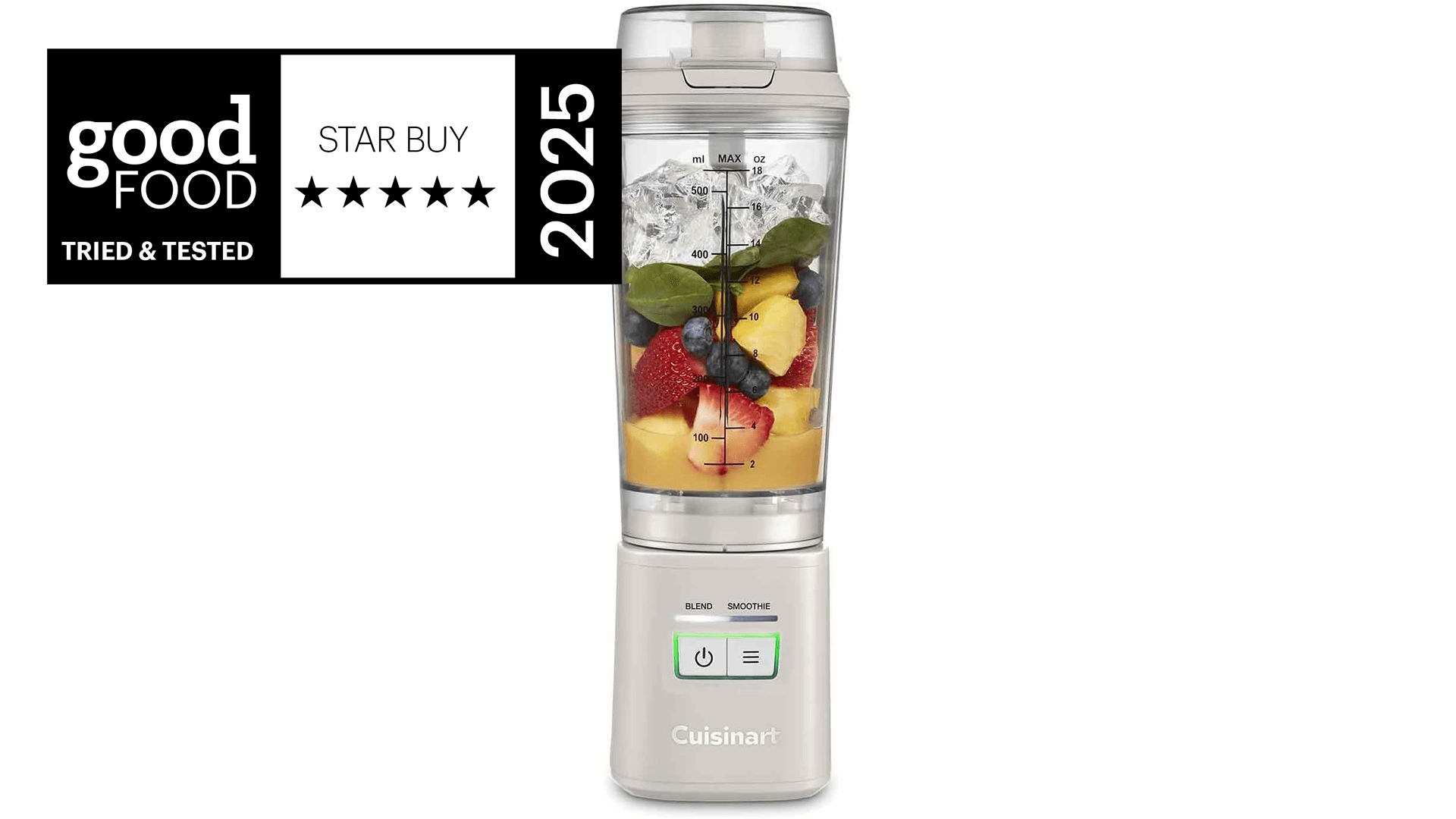
Best compact and portable blender
Pros:
- Compact and cordless
- Eco-conscious packaging
- Portable and travel-friendly
- Three-year guarantee
- Impressive results
- Simple and straightforward
Cons:
- Needs fully charging before first use
- Limited cup capacity
- Two settings
Star rating: 5/5
Wattage: 10W
There is much to be said for simple, straightforward design that delivers what it promises. The Cuisinart Blast & Go Portable Blender is exactly that. After an initial two-hour charge with the USB-C lead, the blender has enough power to whizz through around 20 sessions. After that, you can use it with or without the lead. It’s so lightweight, compact and portable, I could imagine taking this camping or on a self-catering holiday.
The two clearly marked pre-settings, smoothie or blender, blitz through frozen and fresh ingredients in 33 seconds with ease, leaving sauces puréed, and smoothies, super smooth. It was much quieter than others on test, too. The measuring lines on the cup are handy for following recipes, and when you’re finished you can pop that and the lid into the dishwasher.
The 500ml capacity is better suited to drinks and smaller portions of sauces and dips, rather than attempting to whizz up a family soup. Bonus points for the eco-conscious packaging and the three-year guarantee.
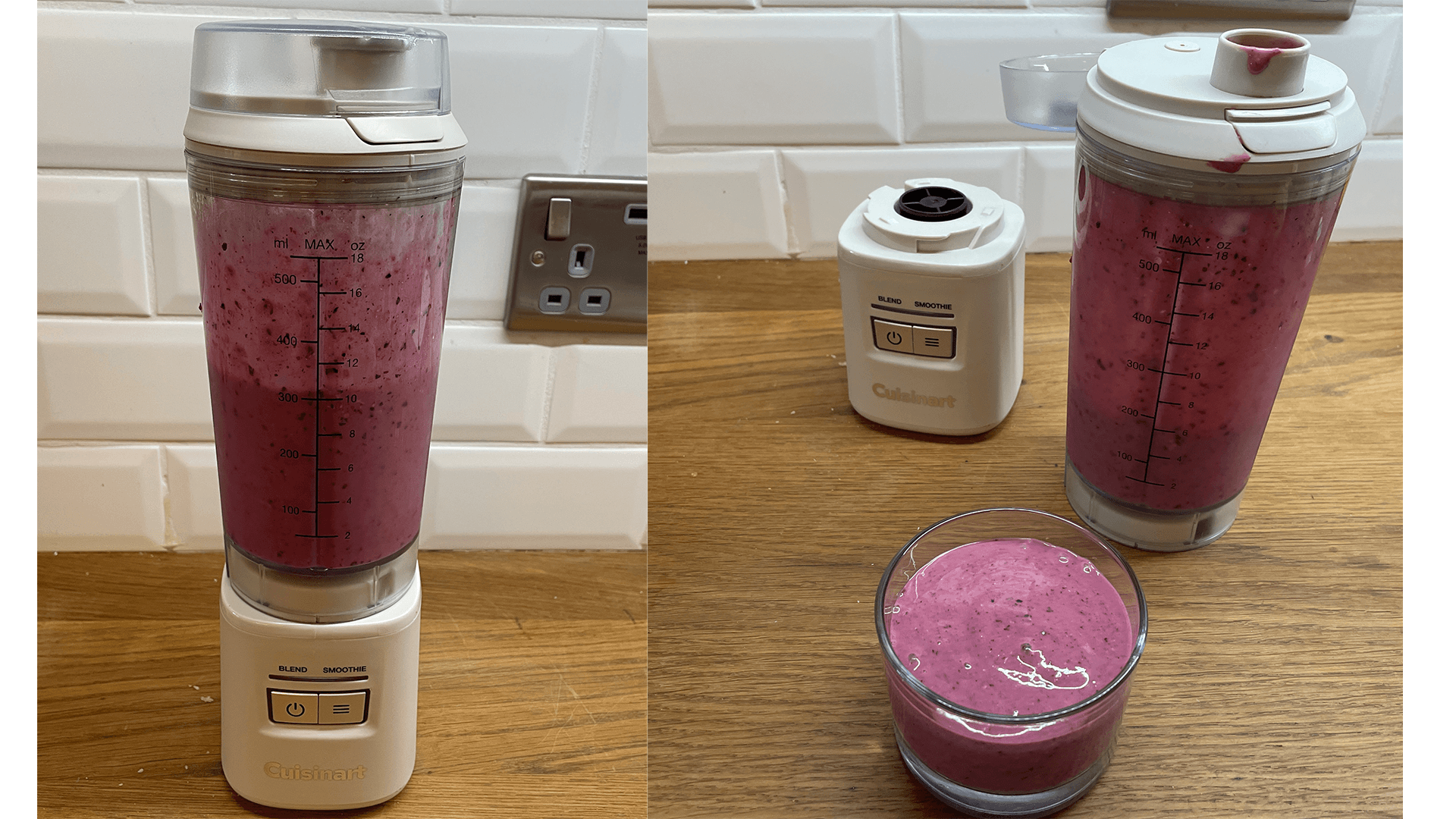
Available from:
Ninja Detect 3-in-1 Power blender and food processor
Available from Amazon (£217), Ninja Kitchen (£229.99), Currys (£229.99), Argos (£229.99)
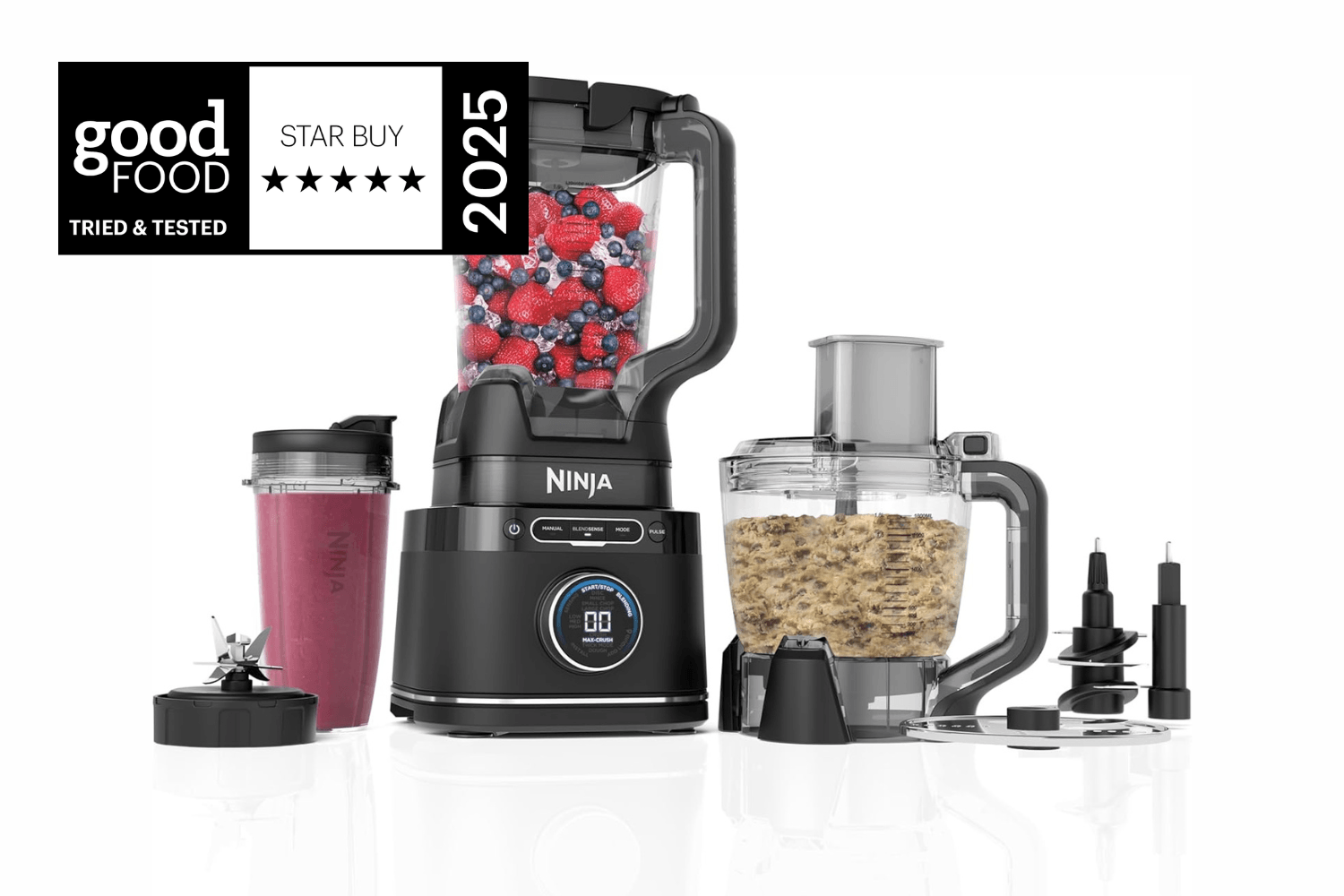
Best high-tech blender
Pros:
- Powerful
- Automatic setting for blending
- Dishwasher safe except the base
- Three to-go cups
- Liquid detection warning
Cons:
- Noisy
- Difficult to get into the dishwasher
Star rating: 5/5
Wattage: 1200W
The Detect 3-in-1 Power blender from Ninja, a renowned brand well-known for its technology, is powerful and well built.
It is sturdily built and boasts numerous features – we particularly liked the BlendSense function, a relatively recent innovation from Ninja that senses and automatically adjusts the blending speed and time in the jug.
It’s able to determine whether you’re using fresh or frozen ingredients and enough liquid; if not, a warning appears on the screen. But once it is happy, off it goes. If you prefer more control, there are manual and pulse functions too.
Although the machine is noisy, blending the smoothie using Blendsense was incredibly fast and thorough with superb results, so we forgave the noise. We used the pulse function for the sauce as we wanted some texture, and again, it was brilliant.
The blender also comes with a food processor, several different blades, a grating and slicing disc and three single-serve lidded cups for smoothies on the go. We think it is well worth the price.
Haier I-Master Series 5 Glass Jug Blender
Available from Amazon (£89)
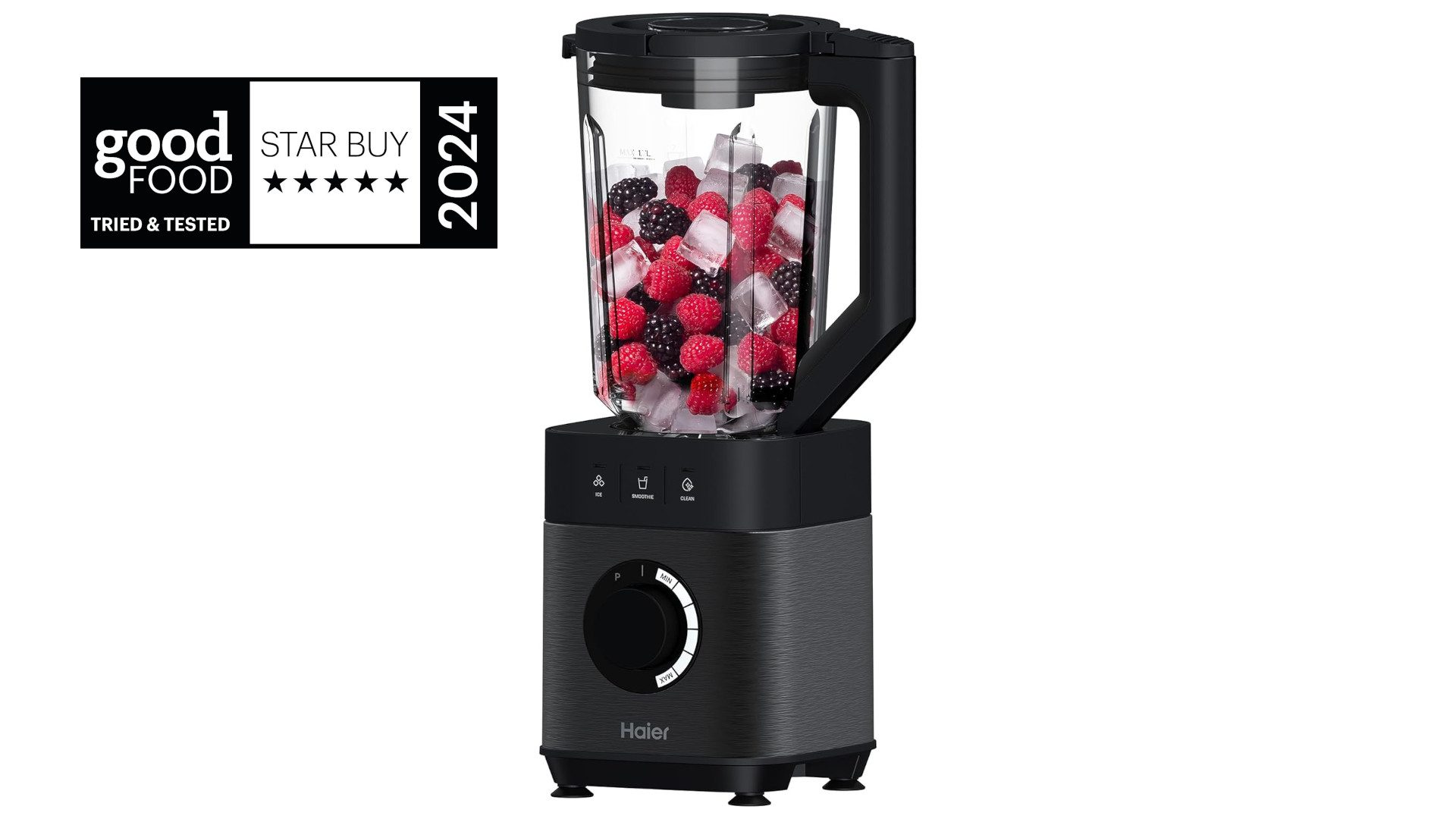
Best blender for easy clean-up
Pros:
- Fully recyclable packaging
- Quality glass jug
- Extra small blender jug included
Cons:
- Illustrated instructions
Star rating: 5/5
Wattage: 1200W
A powerful blender with six blades, the Haier I-Master impressed from the moment we removed its 100% plastic-free packaging. The glass jug gives this model a luxury feel and we liked the look of the illuminated power base controls.
We loved the added extra on this model – a dinky 500ml-capacity personal blender jug which was perfect for smaller batches and to-go smoothies since it came with a lid with snap-open drinking spout.
Noise was at good levels from pulse to max and another bonus was the pulsing AutoClean function, which made quick work of getting rid of residue and left the glass jug and lid attachment clean and ready to go again in around 30 seconds.
What we weren’t so keen on was the instruction manual, which featured a series of pictures rather than clear written directions for set-up and functions. But once we’d made ourselves familiar and tested it to the max with a fibrous beet and kale smoothie, all was forgiven. A great choice.
Ninja Blast
Available at Amazon (£31.99), Currys (£49.99), Ninja (£49.99)
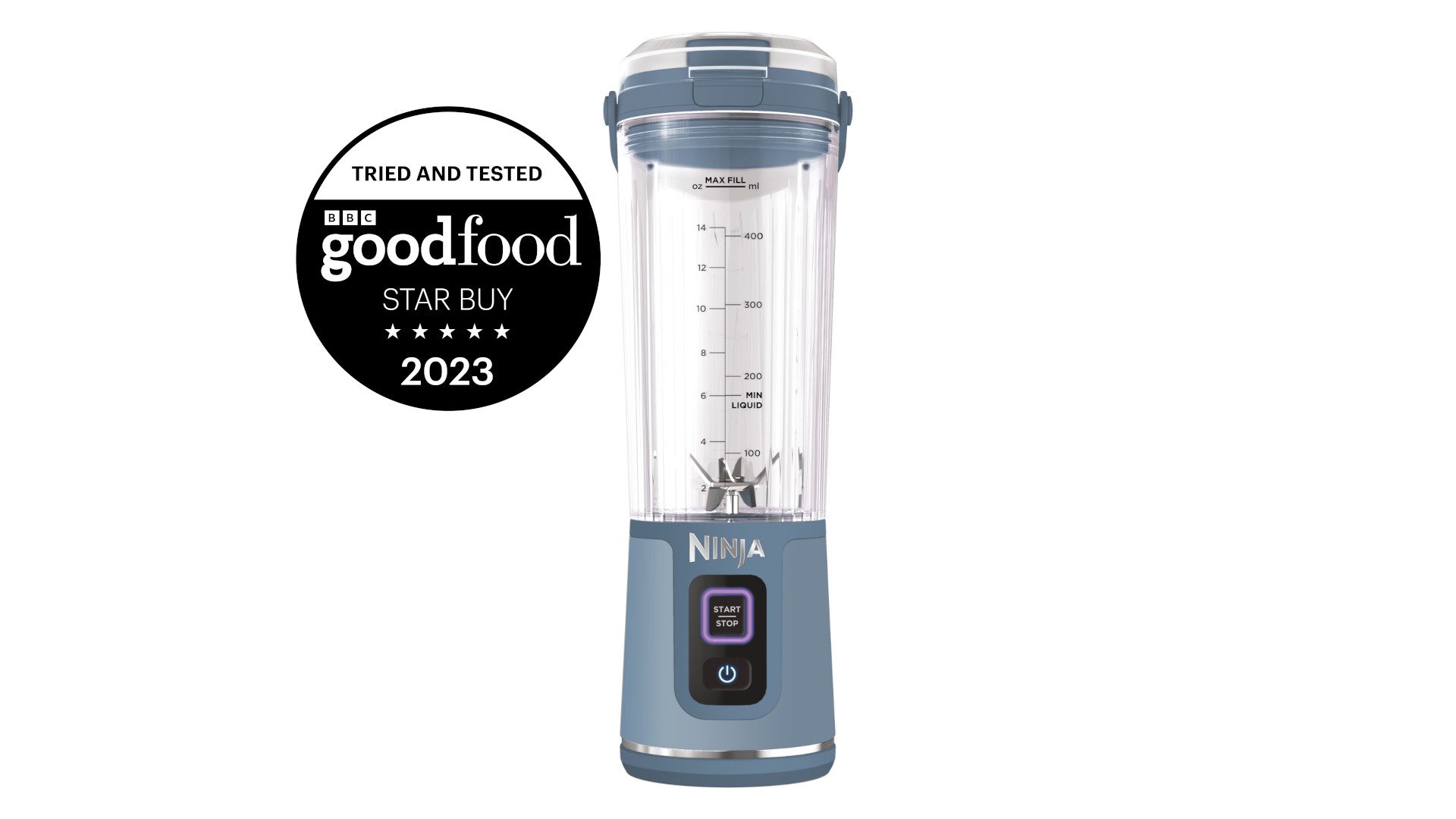
Best portable blender
Pros:
- Easy to transport
- Cordless
- Good-looking
- Produces smooth results
- Runs quietly
Cons:
- Very short charging cable
- No plug included
Star rating: 5/5
Wattage: 14.4W
This powerful cordless gadget makes light work of blitzing and blending on the go. Included in the box is a USB-C rechargeable motor base and charging cord, a 530ml blending cup, a sip lid with a handle, a cup cover, and a blade cover. The cup and lid are also dishwasher-safe.
It needs to be charged for at least two hours before first use, and you’ll need your own USB plug or a multi-port hub to connect it to the mains. We’d advise holding on to the manual, as it contains key information on what each colour means (a flashing orange light around the start/stop button, for instance, means the blades are blocked).
It has an automatic run time of 30 seconds, and in our test the results were smooth and consistent. The sip lid is designed to be leak-proof, too, so you can pop it in your bag without worry.
KitchenAid K400 blender
Available from Wayfair (£296.95), KitchenAid (£329)
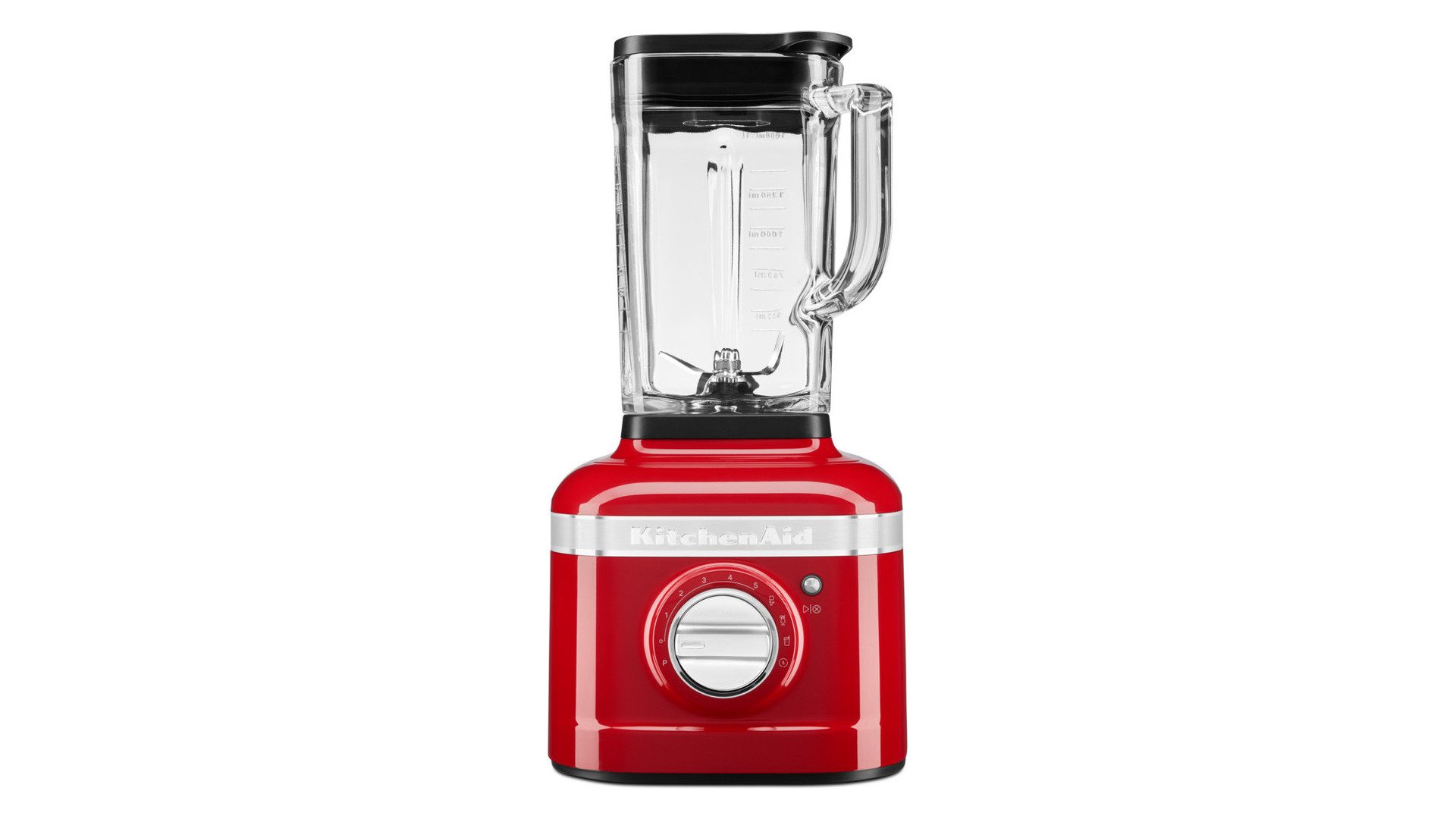
Best blender for keeping on the countertop
Pros:
- Glass blender jug
- Self-clean setting
- Jug hand loads for left- and right-handed people
Cons:
- Heavy to manoeuvre
- Confusing pause before starting its speed settings
- Short flex cord
Star rating: 5/5
Wattage: 1200W
This 1500ml KitchenAid is one for the countertop, elegantly rounded with non-slip feet and a good deal of heft that frankly, makes it impractical to move every time, so this would be a permanent addition to your countertop. This is in part down to the weighty glass jug that lifts on and off and as a nice touch, the handle can be set on the left or right depending which works best for you.
The jug is also notched with helpful ml and oz measurements for weighing directly into the jug to save on washing-up. It’s also dishwasher-safe on the top shelf and, and in test, didn’t hold any colour or smell of tomato after blending sauce. The blades are ready-loaded and secured, which is a pro from a safety perspective.
Read our full KitchenAid K400 blender review.
Sage the Super Q blender
Available from Harts Of Stur (£598.95), Amazon (£599)
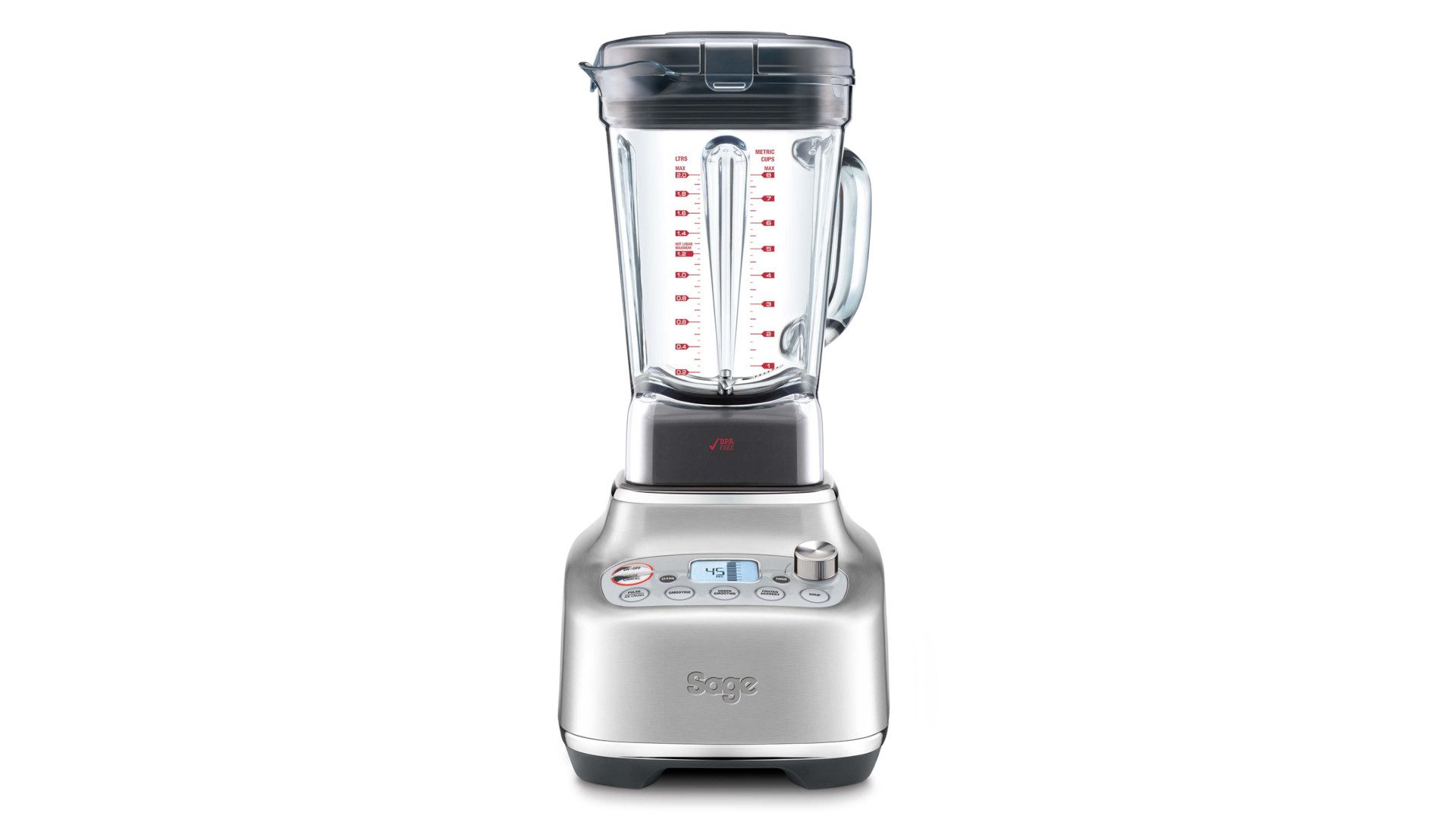
Best blowout blender
Pros:
- High tech functions
- Superb results
Cons:
- Price
Star rating: 5/5
Wattage: 2400W
This Sage blender’s USP is its extra-quiet credentials, with the brand going so far as to patent the technology. Sage specialises in this kind of pioneering functionality, and we felt the Super Q lives up to expectations.
It has all the makings of a professional-level piece of kit, but has been designed with the home user in mind: simple pre-set functions, an in-built timer, handy tools for scraping down the jug, a personal blending cup attachment and more. Most importantly, we found the blitzing results were excellent.
Read our full Sage The Super Q blender review.
Nutribullet Triple Prep System
Available from Nutribullet (£229.99)
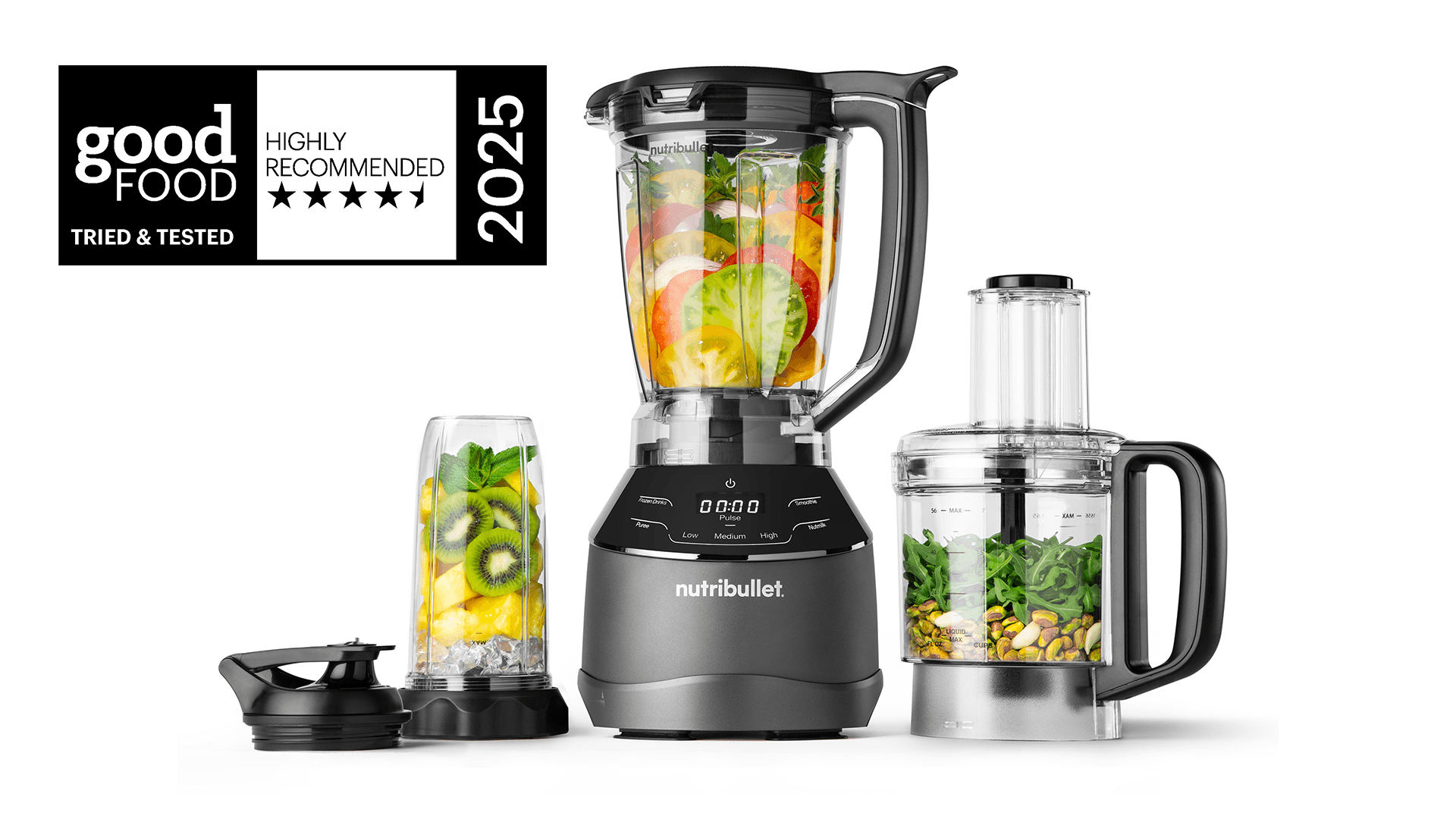
Best blender for doing it all
Pros:
- Clear illuminated touchscreen display
- Intelligent pre-settings
- Very easy to use
- Multifunctional and versatile
- Excellent blending results
- Powerful
Cons:
- It is very noisy
- Requires ample storage
- Excessive packaging
Star rating: 4.5/5
Wattage: 1500W
If you’re looking for a kitchen appliance that, almost, does it all, then the nutribullet Triple Prep System is for you. Packed inside the big box is a single-serve cup, a family-sized pitcher and a food processor for whizzing up all manner of smoothie, sauce, soup, dip or dough. The base unit comes alive with a sleek touchscreen digital display that cleverly detects the attachment you have clicked on and shows the relevant pre-settings for each one, making it a cinch to get started. On test, it powerfully and quickly delivered a super smooth frozen berry drink and a lump-free puréed sauce for pizza, and it was easy to clean up after by hand. Most components will also go in the dishwasher, though the pitcher was too large to squeeze into my slimline one. There’s just one drawback: it’s so very noisy. If you can live with that and have the storage, this is a worthwhile investment.
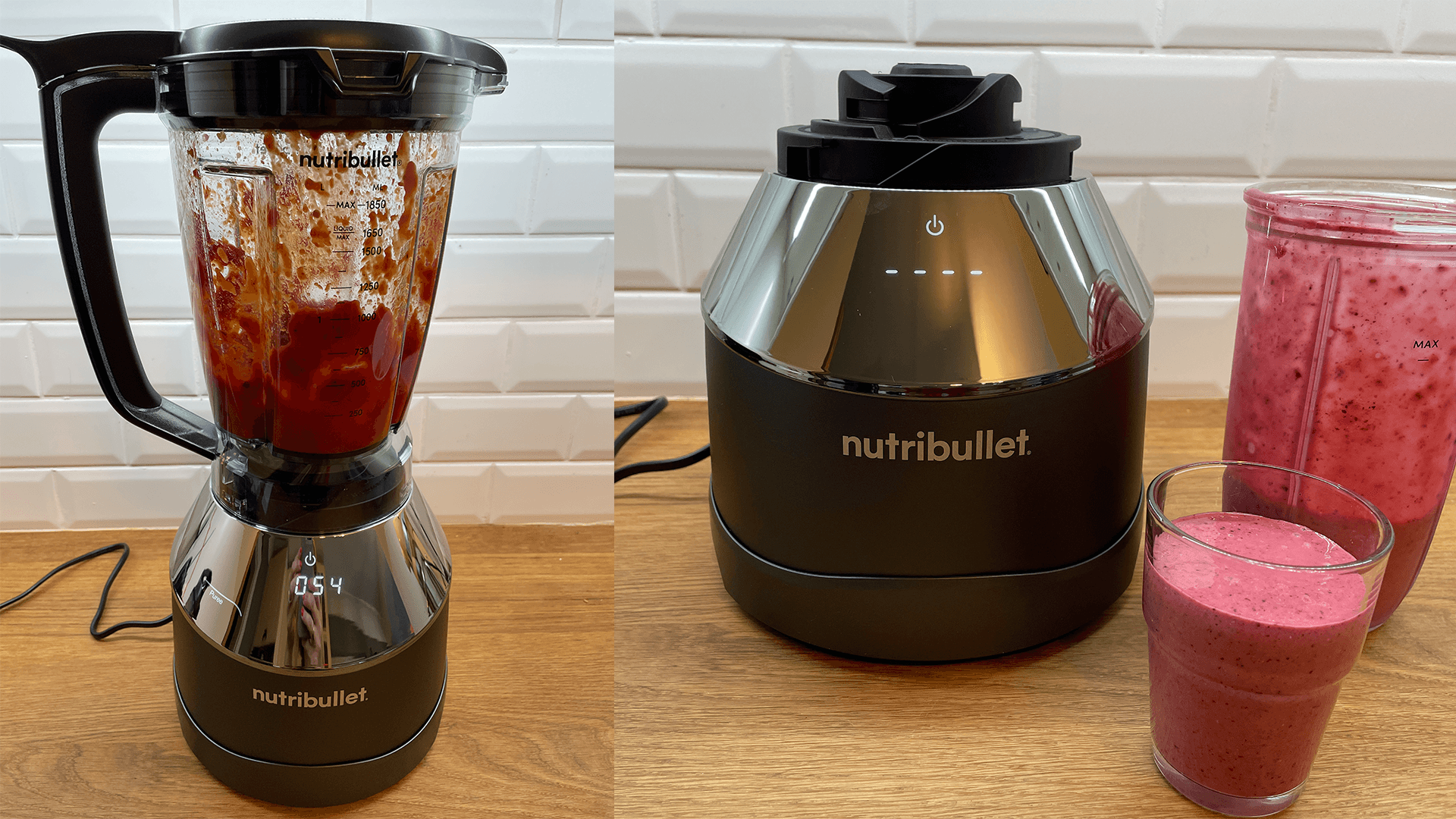
Available from:
Nutribullet Ultra
Available from Nutribullet (£129.99), Amazon (£149.99), Argos (£150)
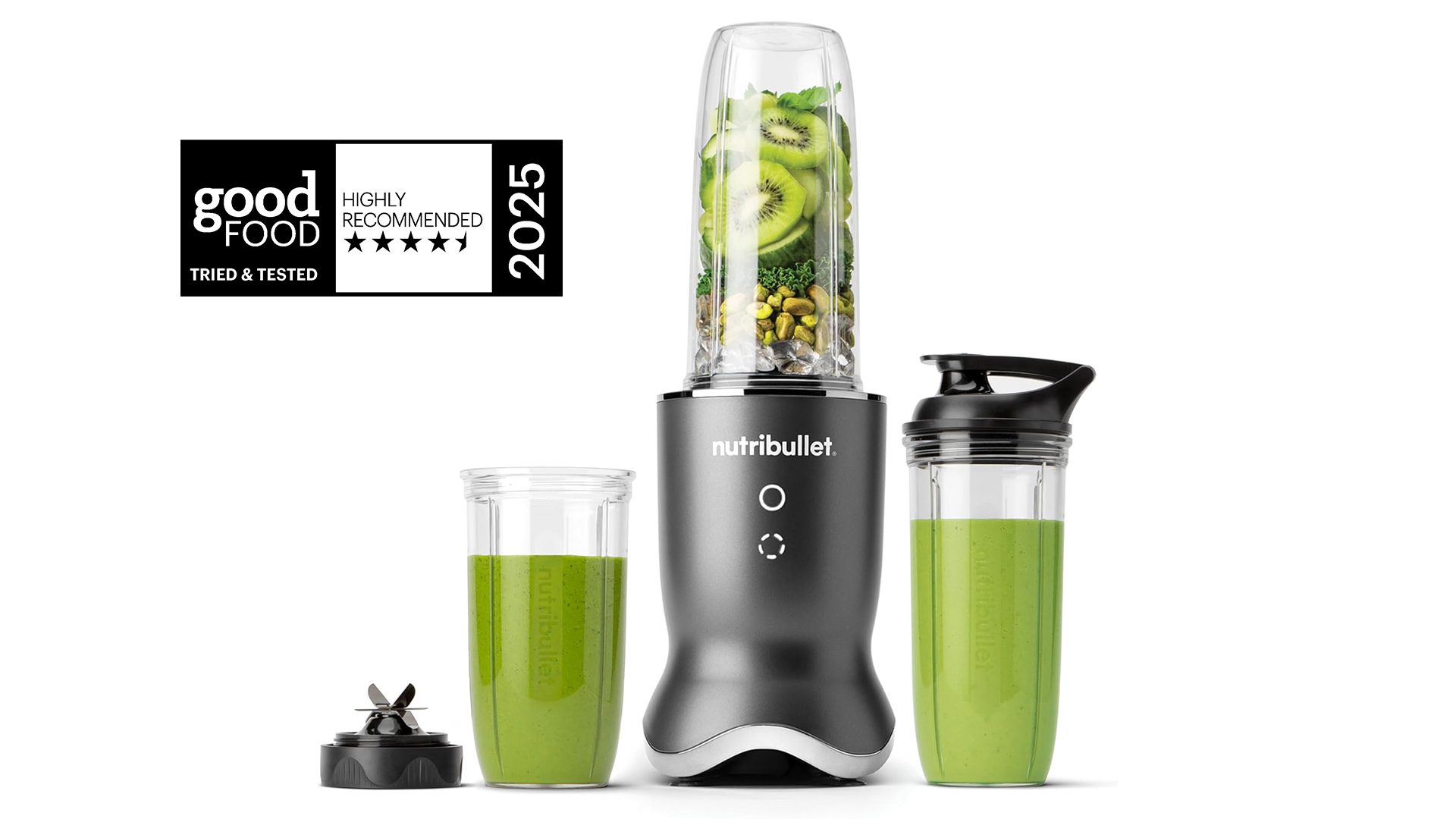
Best all-round blender
Pros:
- Modern and sophisticated design
- Easy to set up and use
- Aesthetically pleasing
- Intuitive controls
- Well-written manual
Cons:
- Noisy
Star rating: 4.5/5
Wattage: 1200W
This small but mighty blender has got it all. With its matt grey finish, it would look good resting on any countertop, while additional parts can conveniently be stowed away with ease. As well as being aesthetically pleasing, it’s also intuitive, simple to use and versatile.
With its 1200 wattage, it’s a powerful model that would suit busy households or families looking to whip up everything from fruit-filled smoothies to pasta sauces in seconds – we found it took on both with ease. It’s intuitively designed, with just two light-up control buttons (one for blend and one for pulse).
The only drawback is the noise – there’s no hiding the fact it’s a very loud blender. But equally it’s also so efficient that only one or two blitzes were needed to make the sauces and smoothies we tested. It’s at the pricier end of the scale for a Nutribullet blender, but given that it’s hard to find fault with it, it’s well worth the price in our opinion.
ProCook Food Blender and Smoothie Maker
Available from ProCook (£119.20)
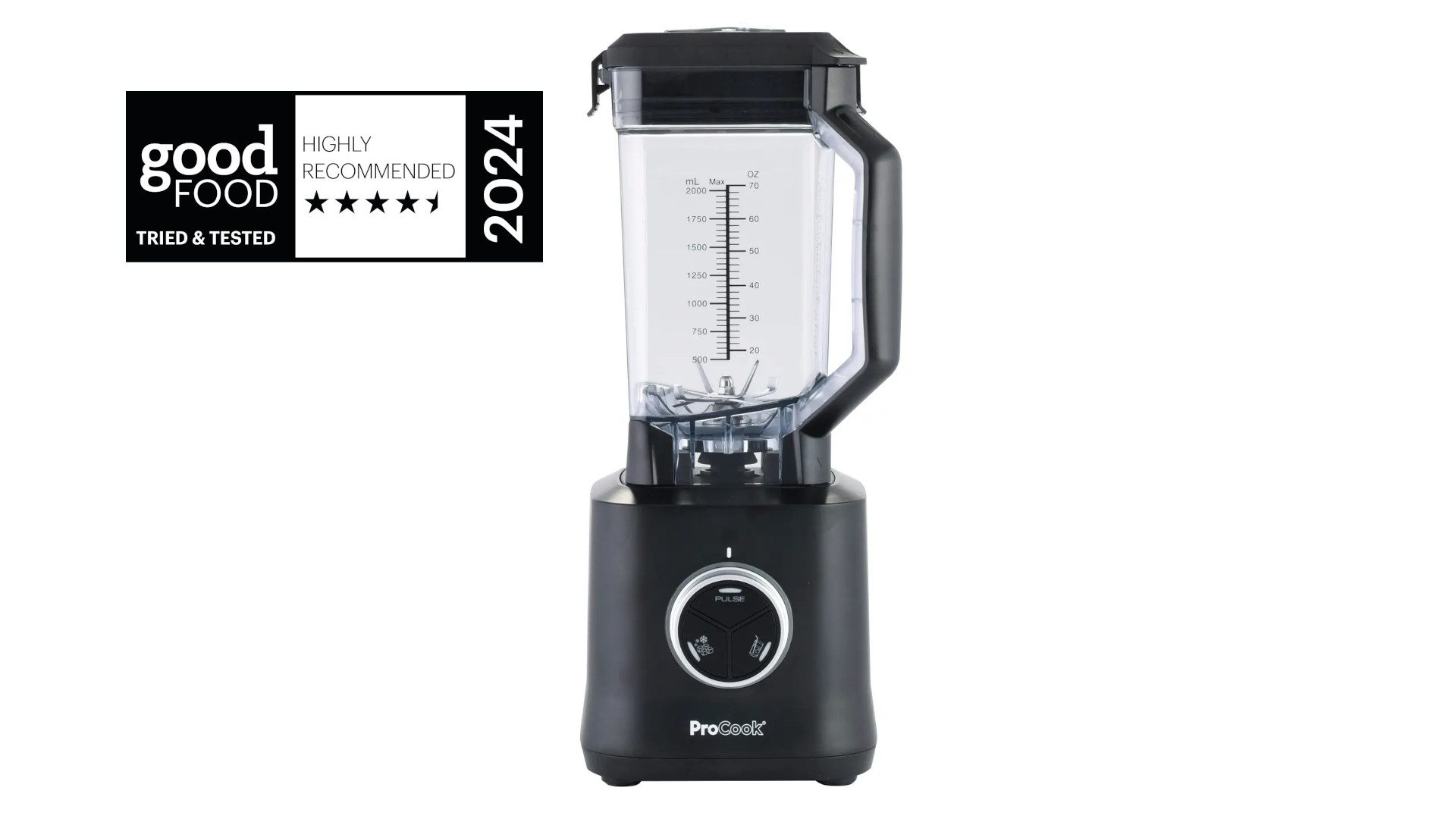
Best blender for batch cookers
Pros:
- Large 2-litre capacity
- Powerful motor
- Handy pushing rod included
- Good safety features
Cons:
- Larger and heavier than some models
- Lid can be awkward to clip in place
Star rating: 4.5/5
Wattage: 2000W
Blitzing ice for cocktails, creating silky soups or whizzing ingredients for our homemade tomato sauce recipe, this ProCook blender made light work of whatever we tried.
Batch cooks will love this model, as the generous 2-litre capacity jug gives you the space to blend family-size recipes without fear of overspill. Turn the dial for increased power, 0-10, or use special ‘ice’, ‘juice’ or ‘pulse’ buttons that vary the strength and frequency of blending bursts. Even at full capacity, the noise level on this model was good.
Although this choice features a Tritan BPA-free plastic jug, it’s of such good quality we’d expect it to withstand heavy use. Unusually, it’s also square, which means you don’t have to twist it on or off – simply place it on the motorised base. However, one small gripe was that the lid had to be positioned in a certain way, with parts aligning – a manoeuvre some round-jugged models don’t require.
Once in place, though, we liked the added safety clips to hold the lid firmly and the suction feet did a great job of keeping this heavy blender steady. With further safety in mind, this blender has both overheat and overcurrent protection, and will pause if overloaded or the blade becomes blocked.
Smeg BLC02 high-performance blender
Available from Amazon (£199.99)
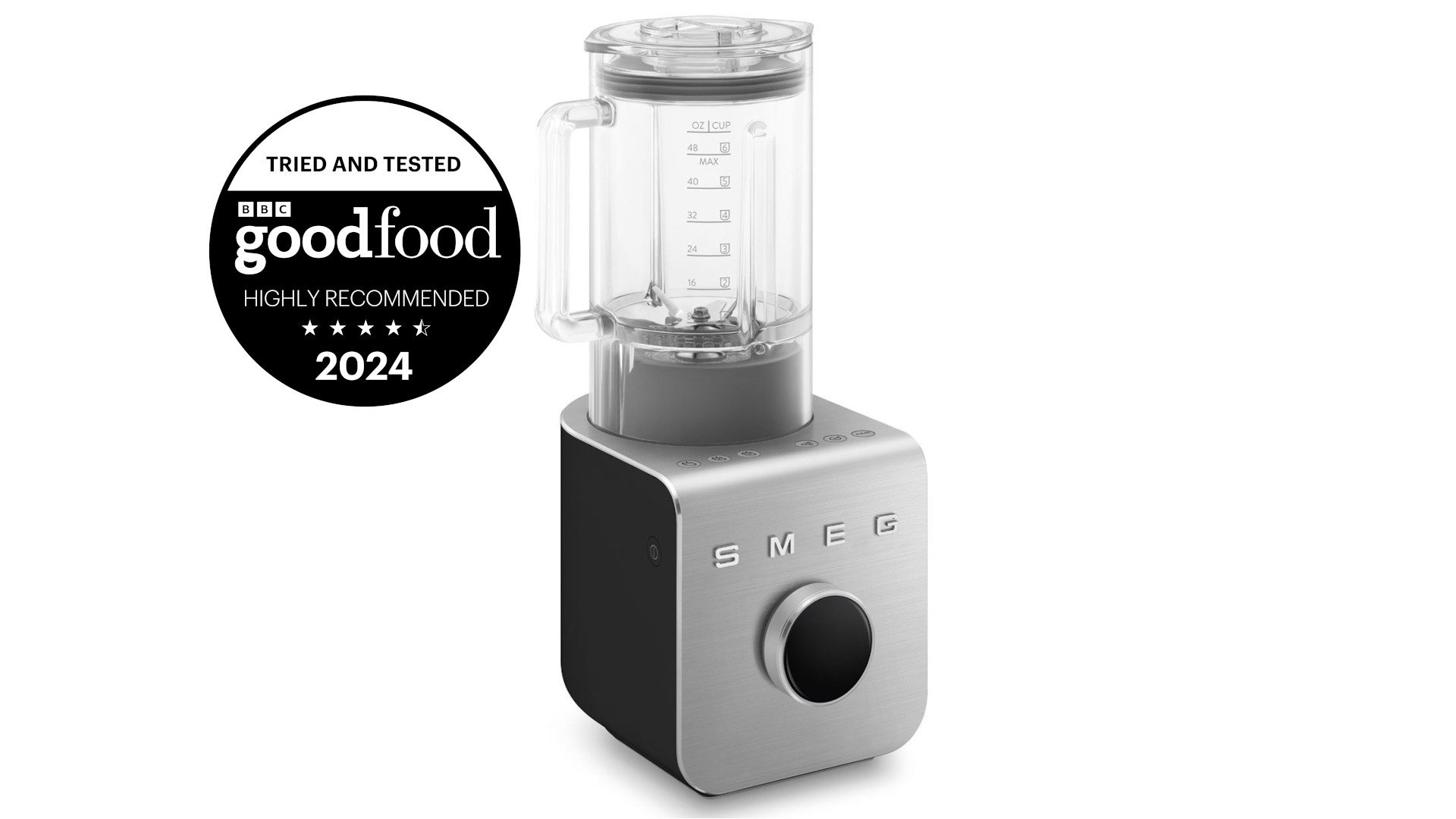
Best smoothie blender
Pros:
- Attractive design
- Robust 1.5-litre jug
- Comes with specific presets
- Bright, intuitive digital display
- Easy to use
Cons:
- Heavy
- Expensive
- Excessive non-recyclable packaging
- Limited information on recycling or spare parts
Star rating: 4.5/5
Wattage: 1400W
A touch more modern than some of Smeg’s other appliances, this blender is boxy but sleek. There are buttons across the top and a large dial on the front, which lights up brightly and allows you to control the speed (on a scale of one to nine).
You can run it manually, but to guarantee the best results there are also four presets: smoothie, green smoothie, frozen dessert or ice crush, plus single-serve and family-serve (three portions) – each of which determines how many seconds the blender runs for. There are extra accessories, too, including a vacuum pump, (to preserve nutrients, colours and flavours), a tamper, spatula, and cleaning brush.
Where this blender scored lowest was sustainability – there was a lot of plastic packaging, and we struggled to find any details on spare parts or recycling in the manual. We also found it very noisy in use, but it did achieve impressively smooth results.
Russell Hobbs Desire jug blender
Available from Argos (£50)
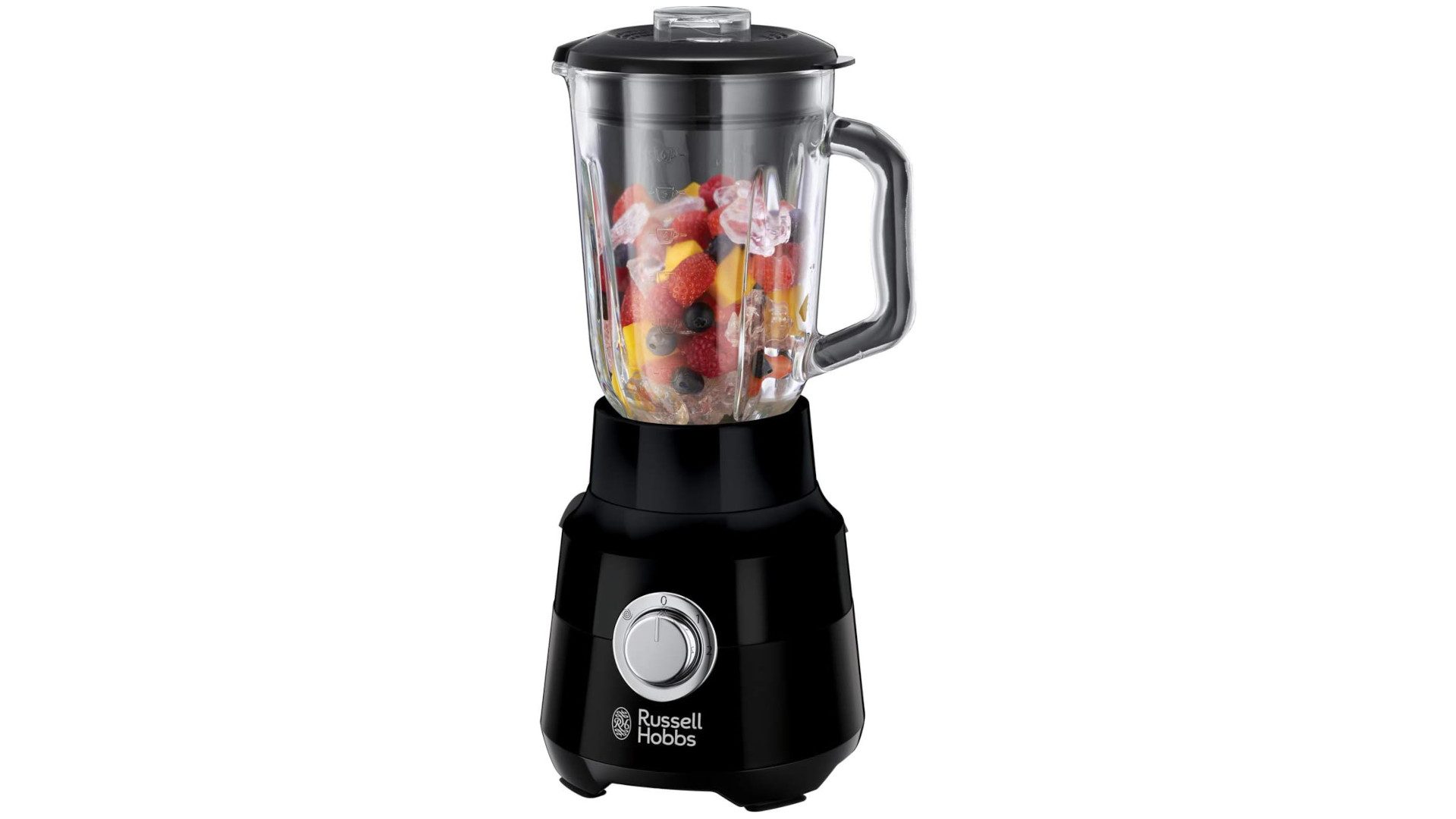
Best budget blender
Pros:
- Good price
- Effective
Cons:
- Only two speed settings
Star rating: 4.5/5
Wattage: 650W
What this sleek-looking blender lacks in multiple functions it makes up for in solid performance and ease of use. It functions as well as more expensive models on the market, so much so it blitzed our tester smoothie so thoroughly you could be forgiven for thinking the drink had been made in a juicer, rather than a blender. It is compact, sturdy, leak-proof and gets a big thumbs-up on the value for money front.
Read our full Russell Hobbs Desire blender review.
Kenwood MultiPro OneTouch Food Processor and Blender FDM73.850SS
Available from Argos (£150), AO (£150), Currys (£169), Lakeland (£169.99), Kenwood (£199.99)
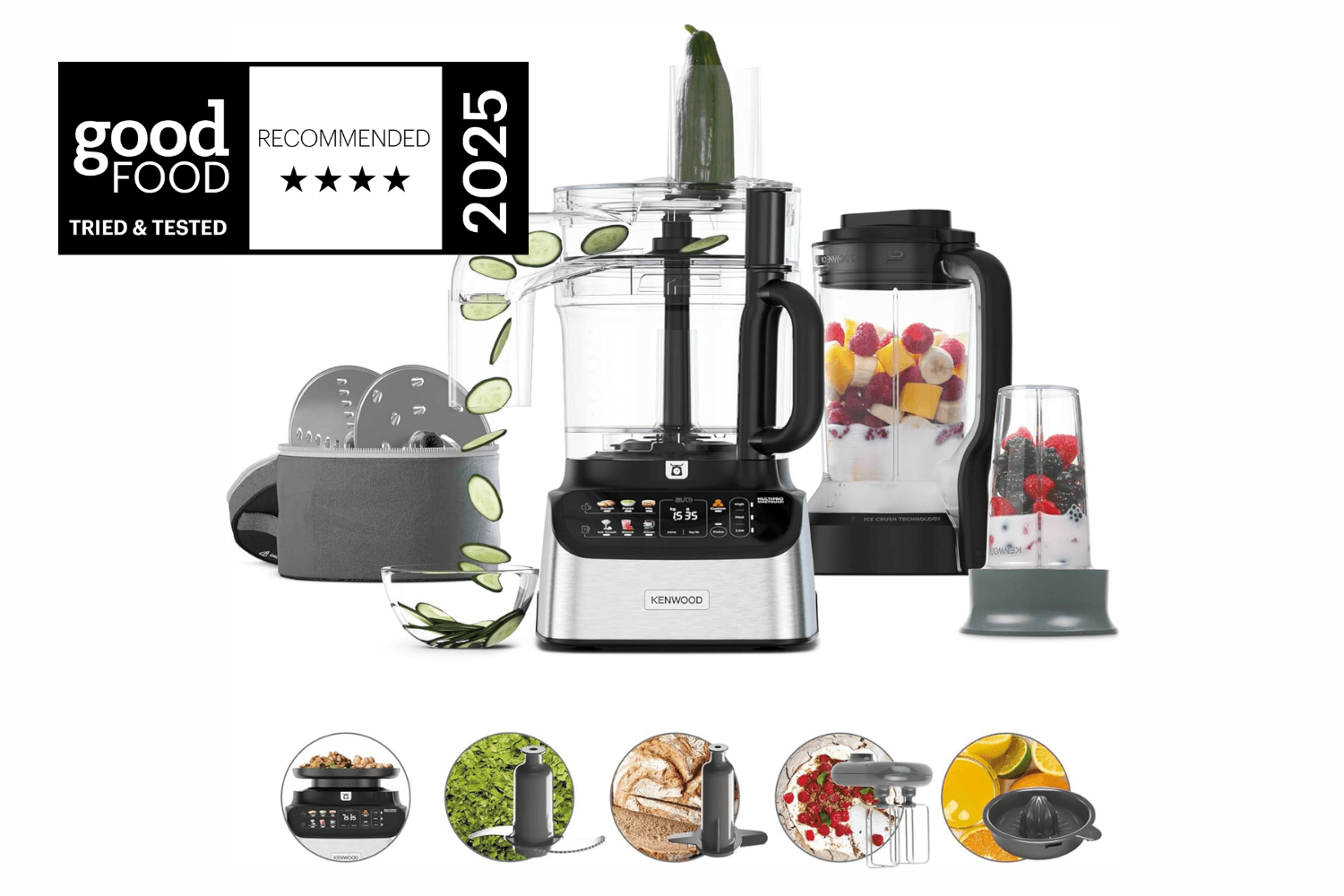
Best blender with built-in scales
Pros:
- Weighing scales
- Good accessories
- Clean function
- One-touch controls
Cons:
- Finger marks
- A little clumsy to add the jug
- The instruction book is difficult to read
Star rating: 4/5
Wattage: 1000W
The Kenwood Multi-Pro OneTouch requires some unpacking and sorting, as it comes with the blender, a food processor and multiple accessories. Assembly is straightforward, although we struggled to attach the jug to the base unit; we are sure this will become easier with practice.
The jug is a decent size, measuring 1.5 litres, with easy-to-read volume markings. Even better, it features built-in weighing scales that allow you to measure directly in the blender or the Blend-Xtract 2GO blender and cup.
Using the Kenwood blender is easy with its intuitive One-Touch buttons, which include a cleaning function that we loved, although all but the base are dishwasher-safe.
The tomato sauce blended beautifully using the pulse function, however our smoothie needed to be scraped down and re-blended. Though when finished it was good overall, if a little grainier than we would have liked. All in all, though, considering everything that comes with the Kenwood, a little scraping now and again isn’t too much of a problem.
Nutribullet Flip
Available from Nutribullet (£74.99)
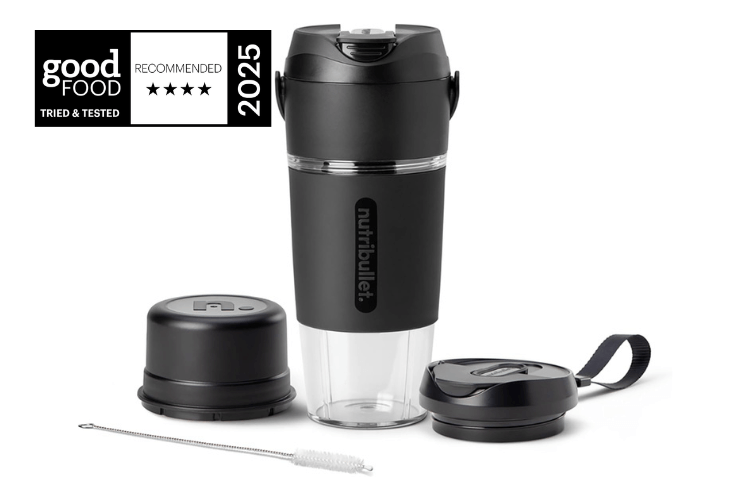
Best blender for travel
Pros:
- Portable
- Compact
- Well insulated
- Easy-to-clean
Cons:
- One speed setting
- Not as powerful as other models
Star rating: 4/5
Wattage: 120w
Ideal for those on the go or wishing to make ice-cold drinks, this nifty handheld blender whizzed up a berry smoothie and tomato sauce with relative ease. The model is easy to use, with just one button and one set speed. As the name suggests, it’s simply a case of securing the lid with the blade attached and flipping the model to use.
The real benefit of this blender, in addition to being portable and coming with a USB-C charge, is the portable 590ml stainless steel insulated blending cup which can keep liquids cool for up to 24 hours.
Overall, it created a generally smooth smoothie – and a very smooth sauce – and the fact the smoothie was ice-cold to drink was an added benefit. Given this model can keep drinks cool for an impressive length of time, we feel it would be ideal for use in the summer, such as for holidays or camping trips, or for avid gym goers. The fact that it self-cleans – simply add a drop of dish soap and water to the blending cup – is another boon.
Nutribullet Magic Bullet Blender
Available from Amazon (£49), Nutribullet (£49.99)
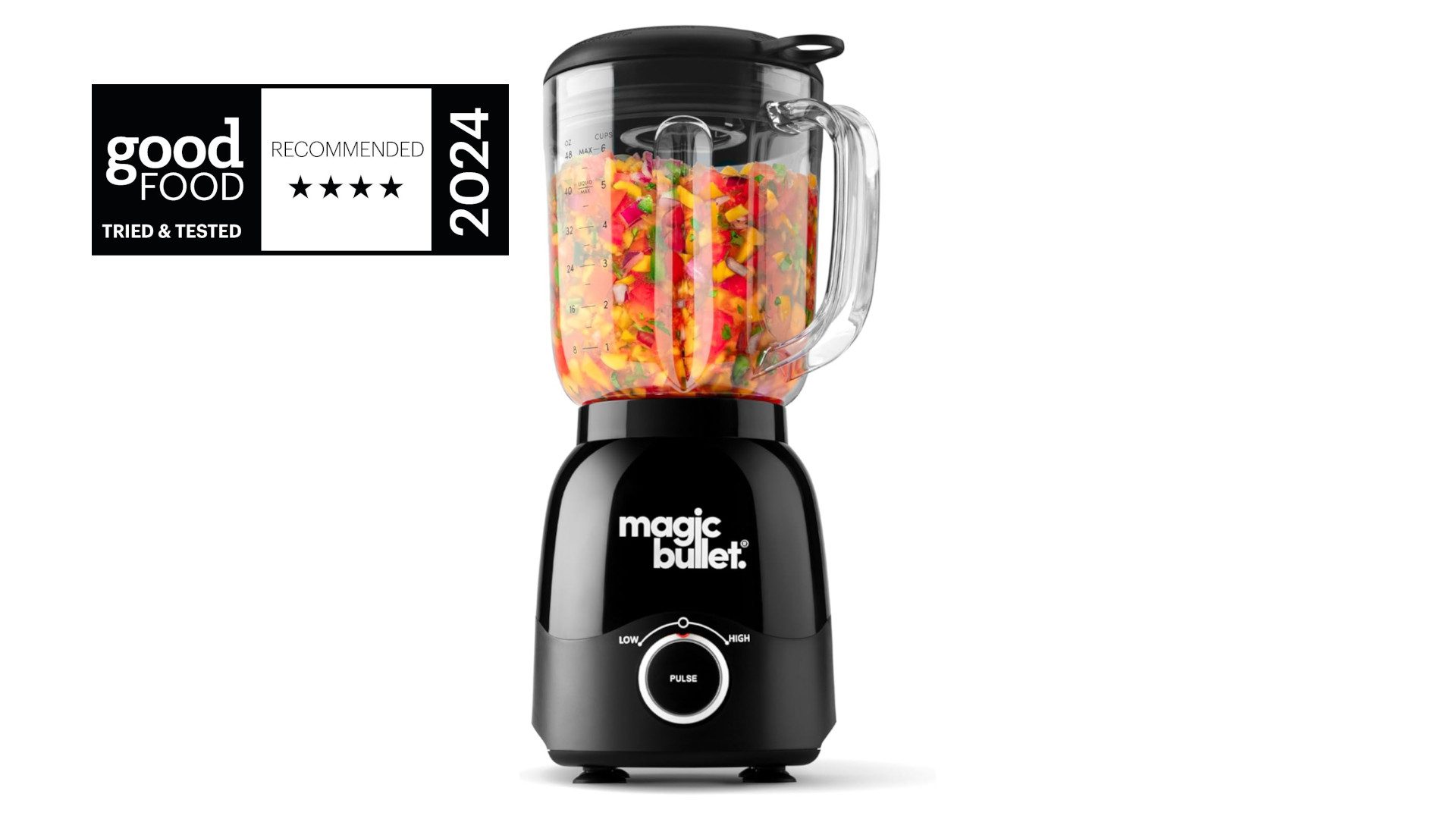
Best blender for small spaces
Pros:
- A bargain
- Small in size with decent jug capacity
- Simple to use
- Dishwasher-friendly jug and lid
Cons:
- Tricky screw-in jug attachment
- Plastic jug
Star rating: 4/5
Wattage: 600W
It took a bit of twisting and repositioning to attach the blade unit to the base, which resulted in a leak when we first tried it. But once we’d screwed the jug in correctly, the Magic Bullet was easy to use. Having only one button with a ‘low, medium and high’ dial, there’s not a lot to get to grips with – you can also press it for pulse action.
Performing well on soups and dressings, we were also impressed with the Magic Bullet’s super berry smoothie-making capabilities on fresh fruit. More fibrous ingredients, such as healthy kale and beets, struggled, however, as did large frozen chunks. We had to stop the machine to stir things up.
The see-through lid could twist off when we needed to add a little more liquid, resulting in a nicely aerated, silky drink. The jug on this model is plastic rather than glass, so is lighter to use than those with, but we wonder if its black measurements will stand the test of time, compared to those with glass containers that typically have moulded indicators.
At under £40, this is an efficient, compact machine for those who may not have their blender in daily use and want to stash it away in a cupboard rather than keep it out on the countertop.
Zwilling Enfinigy table blender
Available from Zwilling (£129), Robert Dyas (£187.99), Harts Of Stur (£198)
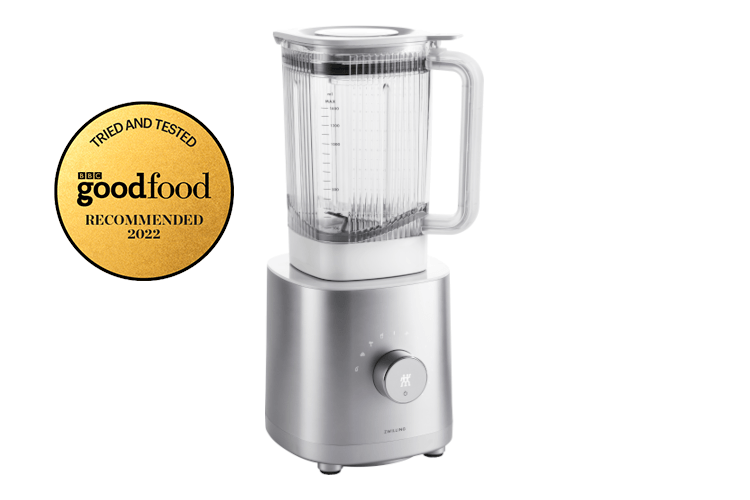
Best jug blender
Pros:
- Plenty of speed options
- Lid must be in position to switch on
- Available in two colours
Cons:
- Backlit display isn’t very clear
- Handle can only be placed to right side
Star rating: 4/5
Wattage: 1200W
The Zwilling Enfinigy table blender is up there with some of the pricier blenders on this list. But what you get for the money is a capable all-round blender that offers ample speeds as well as three blending programmes and a self-clean programme. The serrated blade blitzed through all of our test foods with ease, but if you’re looking for a blender that can handle big batches of soup, this 1.4 litre jug might be too small.
It’s a sleek and streamlined blender that matches several other appliances in the Enfinigy range. We thought the controls were simple to use, and liked that it doesn’t switch on until the lid is firmly locked into position – a great safety feature. On balance though, we were disappointed with the clarity of the backlit display and that the jug can’t go in the dishwasher.
Read our full Zwilling Enfinigy table blender review.
Nutribullet SmartSense Blender Combo
Available from Nutribullet (£149.99)
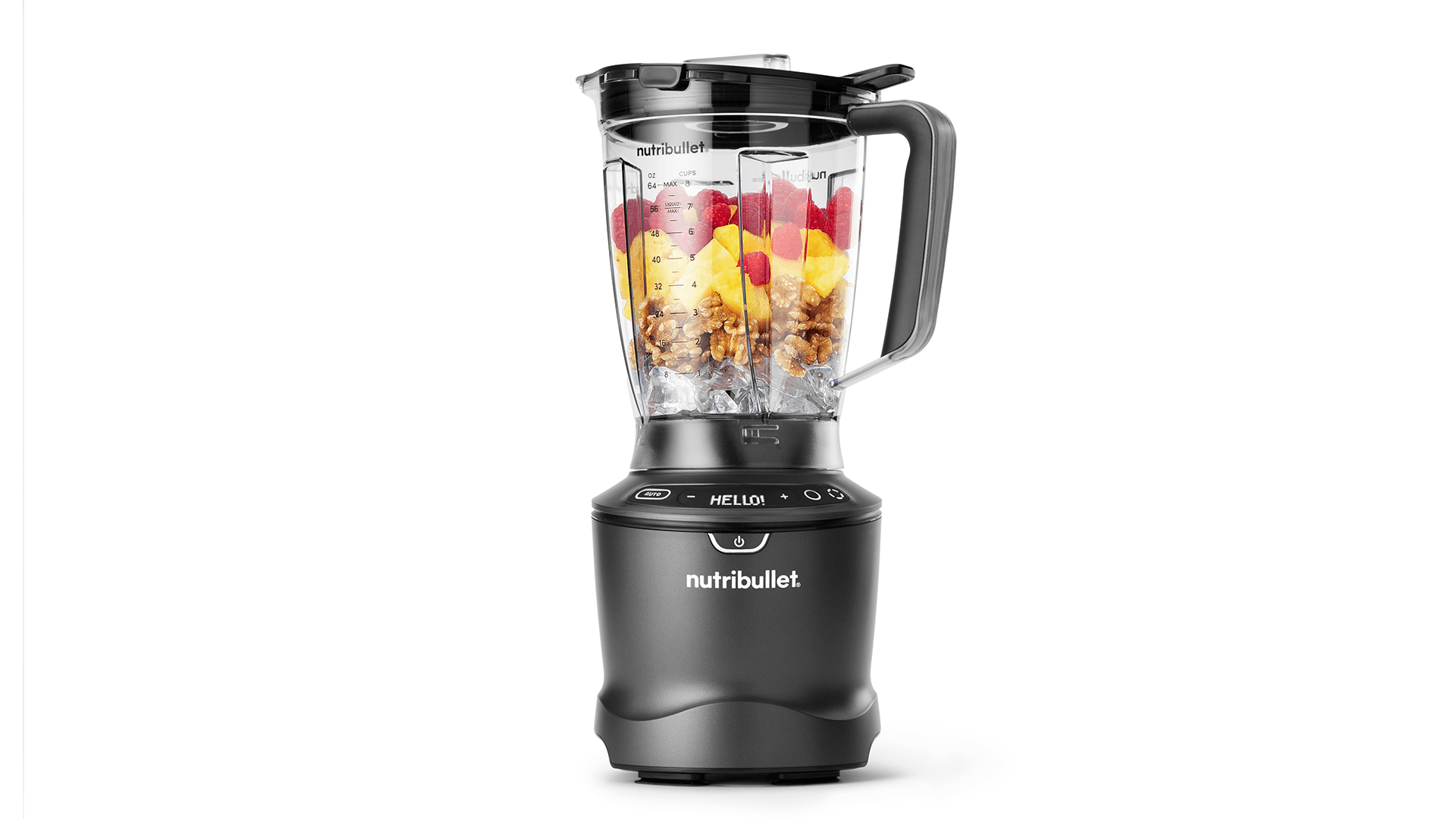
Best family-sized blender for soups and smoothies
Pros:
- Sleek matte black design
- Excellent smoothie results with the pitcher
- Easy to drink travel cup
- Comes with two portable cups
- Quick and powerful
Cons:
- Very noisy
- Not very intuitive
- Not suited to smaller volumes
- Cup component disappointed on test
- LED display is hard to read
Star rating: 3.5/5
Wattage: 1500W
If there was a rating for charm, the nutribullet SmartSense Blender Combo would be at the top of the list, with the sweet little “hello!” and “bye!” it delivers when you power on and off. Unfortunately, once awake, it turns rather shouty, as it powerfully blasts through smoothies and sauces with a volume that is so surprising and loud it made me jump and cover my ears. I first tested the cup blender, however, it struggled so much with both the frozen berry recipe and cooked sauce, I gave up and decanted them into the pitcher.
The pitcher really is the hero here; with that you can blend up a week’s batch of soup for two, serve a small group with the most deliciously creamy, smooth and bubbly shakes, or decant drinks to go in the handy pair of leakproof, lidded travel cups.
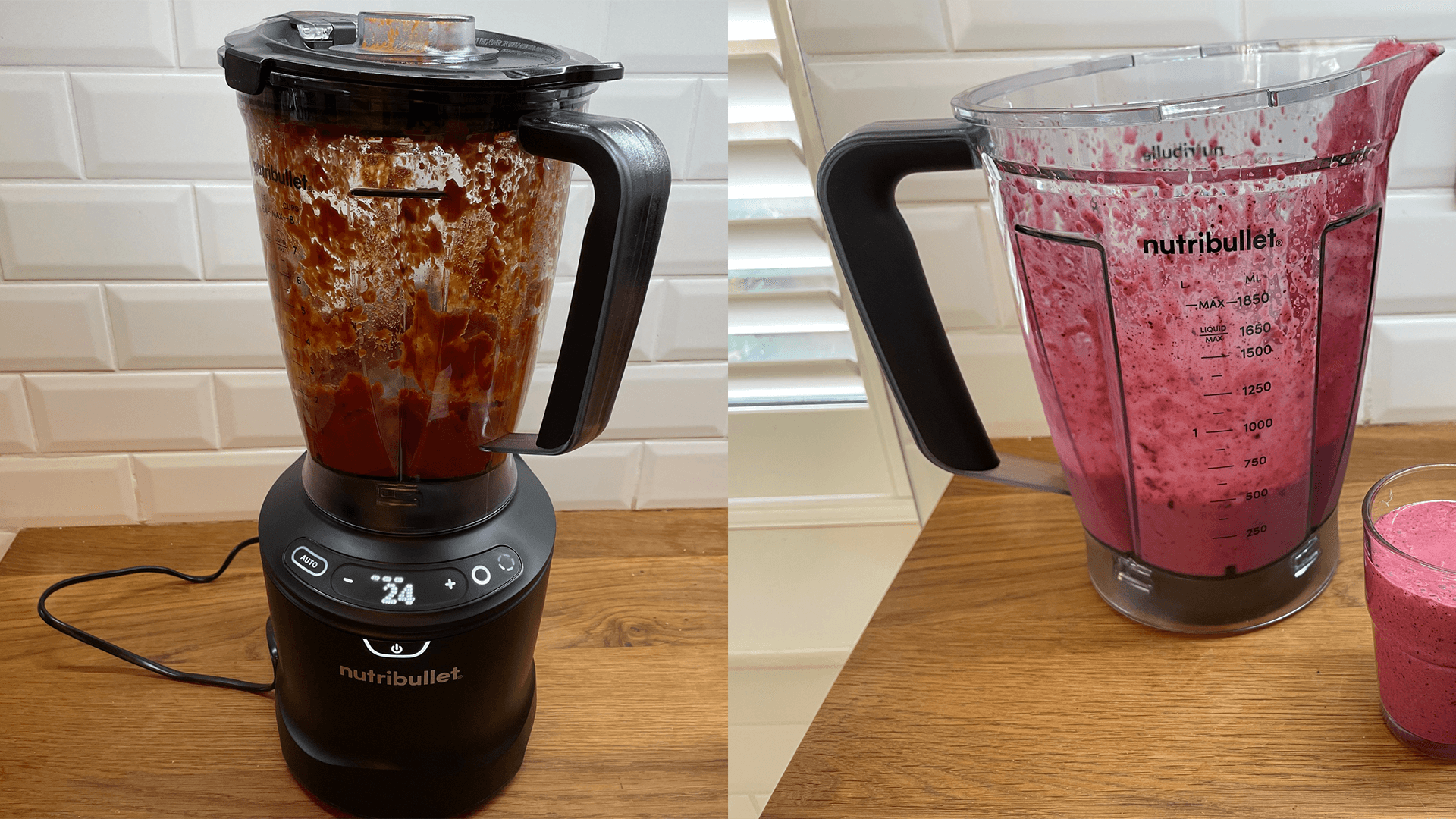
Available from:
Other blenders tested and rated
- Vitamix Ascent review, £669
- Nutribullet blender review, £99.99
- Magimix 1.8L Le Blender review, £289.24
- Ninja 2-in-1 blender with Auto-IQ review, £134.52
- Kenwood Blend-X Fresh Blender review, £66.99
- Tefal Perfectmix blender review, £95
How to choose the best blender
What is a blender?
Stand blenders come in all different shapes and sizes with a range of specifications and price points, so it’s best to evaluate the overall demands of your lifestyle and kitchen, and also the space you have available. Some of the more advanced machines tend to be bulkier and heavier, with larger jugs and stands.
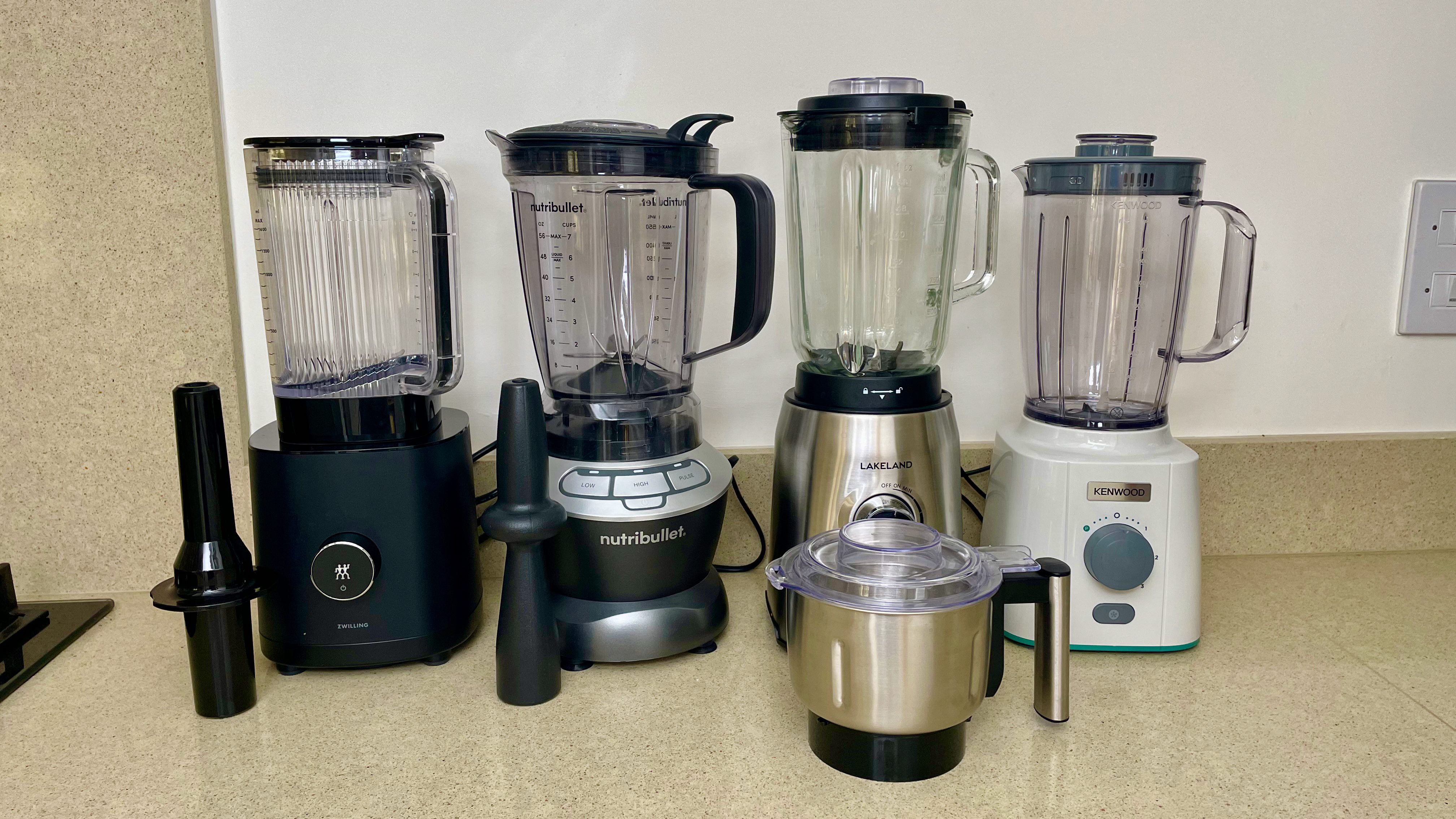
What to look for in a blender
- Pulse function
- Variety of speed settings
- BPA-free plastic or glass jug
- Measurement notches on the jug
- Self-clean function
- Auto shut-off in case of overheating
- Plunger
- Pouring spout
- Individual smoothie cup with a sealed lid
What can you use a blender for?
It’s worth identifying whether you need a straightforward blender, purely for the sake of blending smoothies and soups, or whether you’d like additional functions such as ice crushing, the ability to blend hot ingredients, or the power to pulse ingredients such as nuts and seeds.
Finally, if you’re short on time, and looking to save on the washing-up, it may be worth looking for a device that comes with its own to-go cup which you can blend smoothies directly into – you can find these at different price points, depending on your budget.
How to clean your blender
Clean out obvious debris as soon as you can after use – skinny spatulas are great for tricky corners. Many models come with dishwasher-friendly components, so pop the jug on the bottom dishwasher drawer with the lid and place any inserts on higher trays or the cutlery basket.
Please don’t plunge your hands into soapy water to scrub at the blade attachments – they’re razor sharp, rotate and can be at peculiar angles. Safety first: fill the blender jug halfway with hot water and the tiniest squirt of washing-up liquid. Now ‘blend’ the mix on full power for a minute or so and rinse thoroughly before leaving upturned on the drainer to dry.
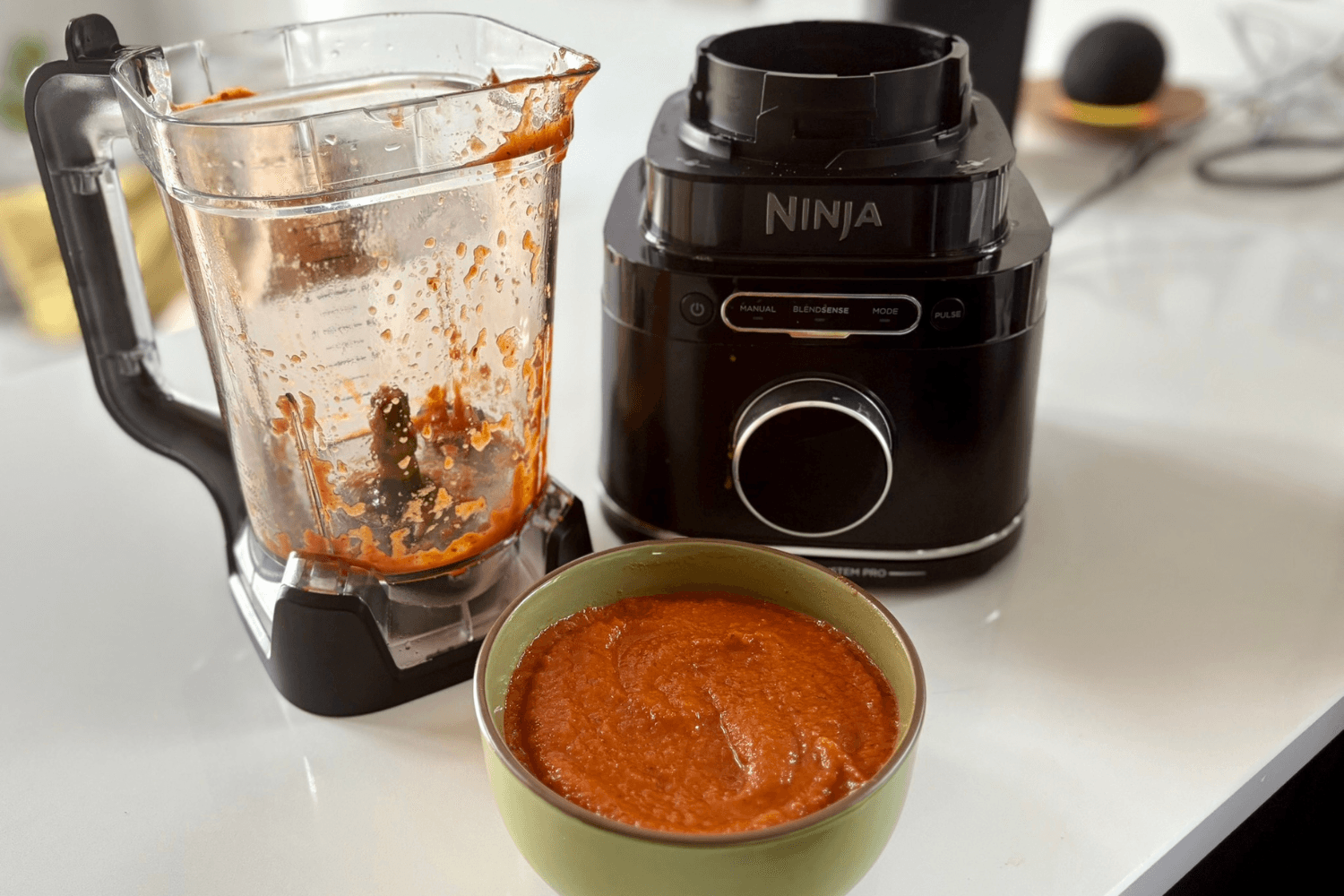
More reviews
Best personalised water bottles
Best kitchen sieves
Best food processors
Best mini choppers
Best smoothie makers
Best spice grinders
Best hand mixers
Best veg boxes
Ninja Creami vs Deluxe
Best Cuisinart ice-cream makers
Best smoothie blender
Ninja Slushi first look review
What equipment do they use in The Great British Bake Off?
Blender recipes
Soup recipes
Smoothie recipes
8 new ways to use a blender
Super berry smoothie
Mango and passion fruit smoothie
Spiced carrot & lentil soup
Three-minute blender banana pancake
More deals
Air fryer deals
Coffee machine deals
Microwave deals
Fridge freezer deals
Dishwasher deals
Stand mixer deals
Pizza oven deals
Breadmaker deals
If you have any questions, suggestions for future reviews or spot anything that has changed in price or availability please get in touch at goodfoodwebsite@immediate.co.uk.
Do you use a blender? We’d love to hear your product suggestions – leave a comment below.



